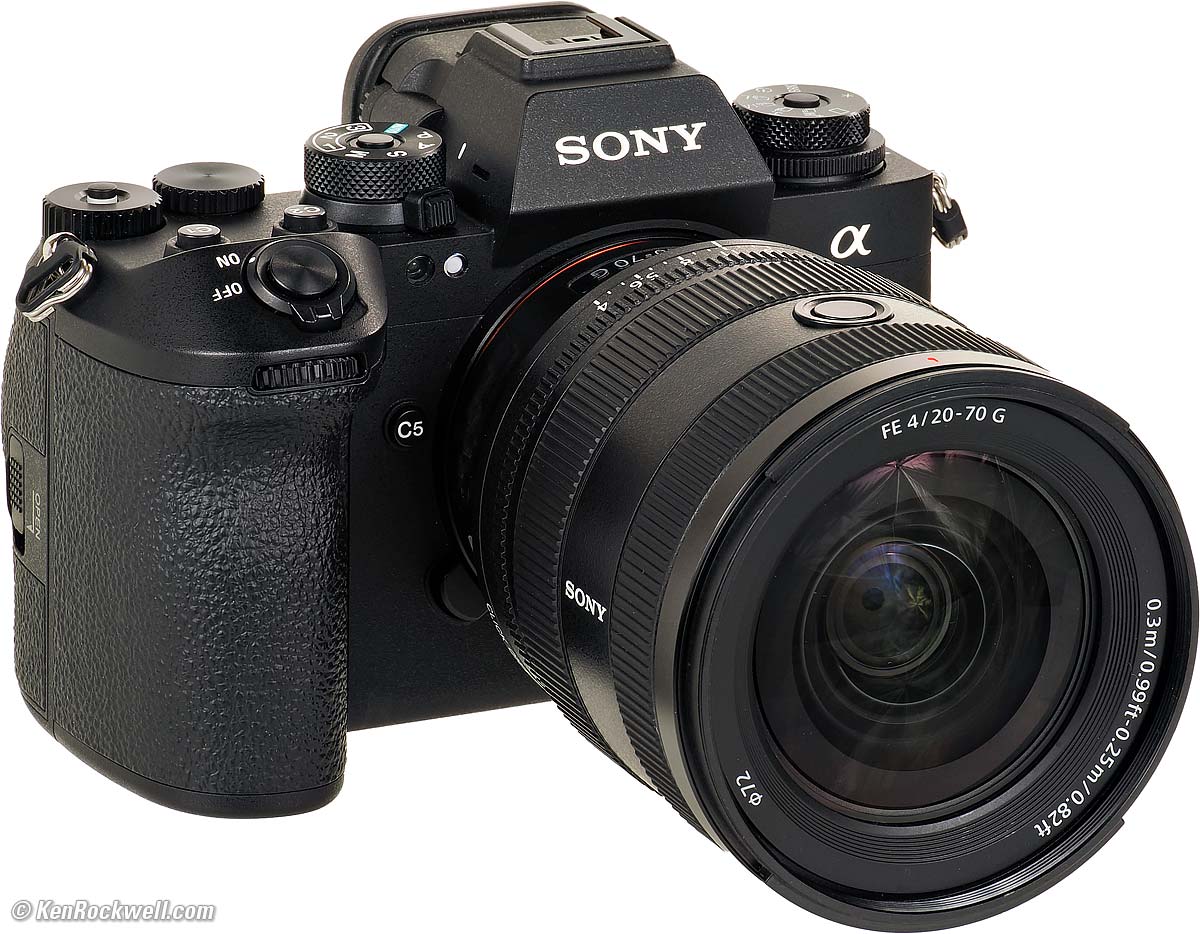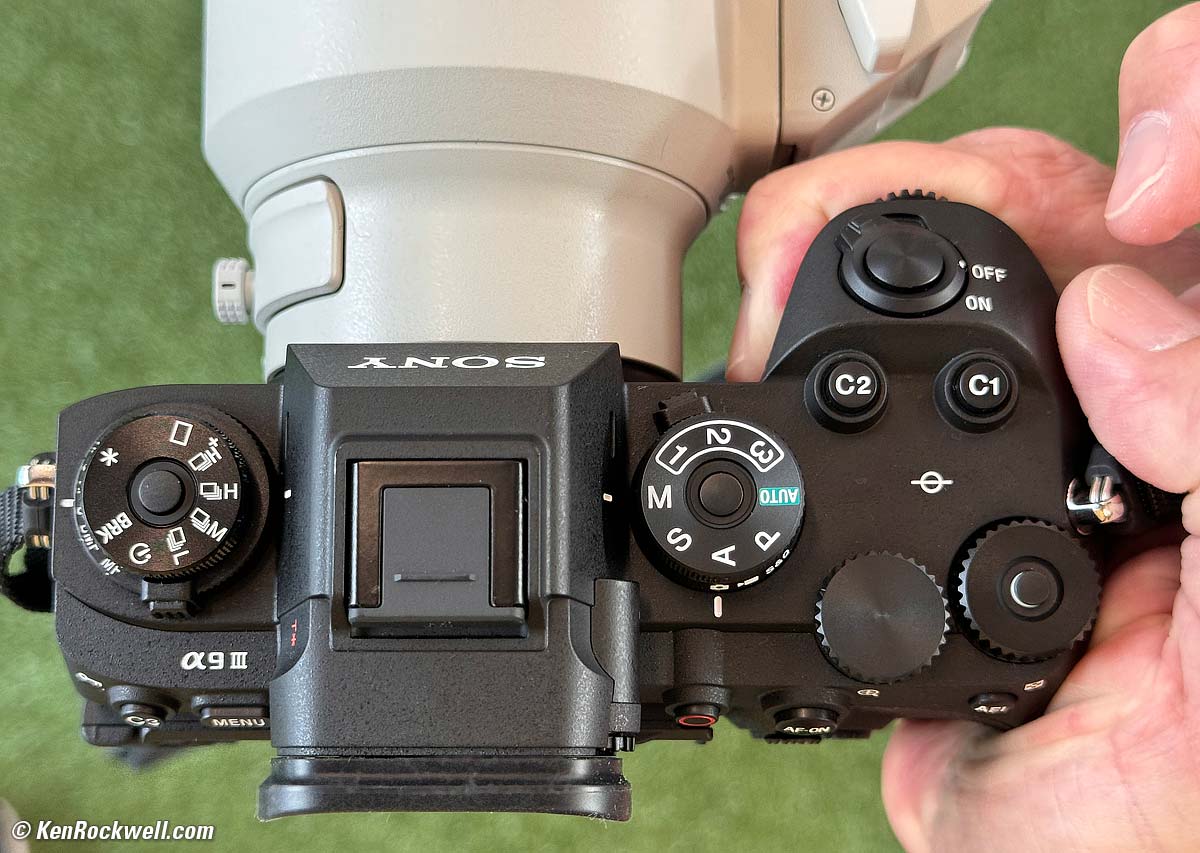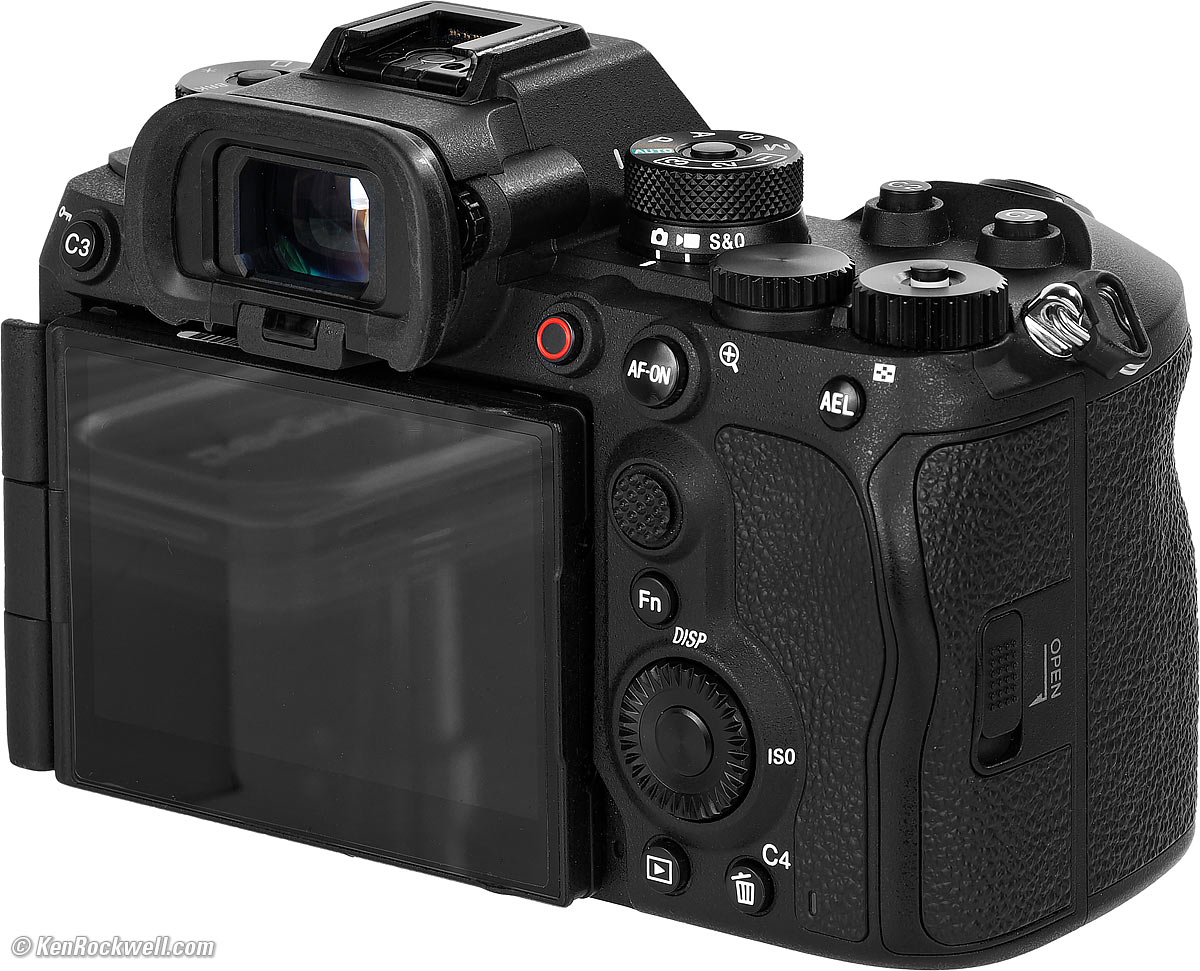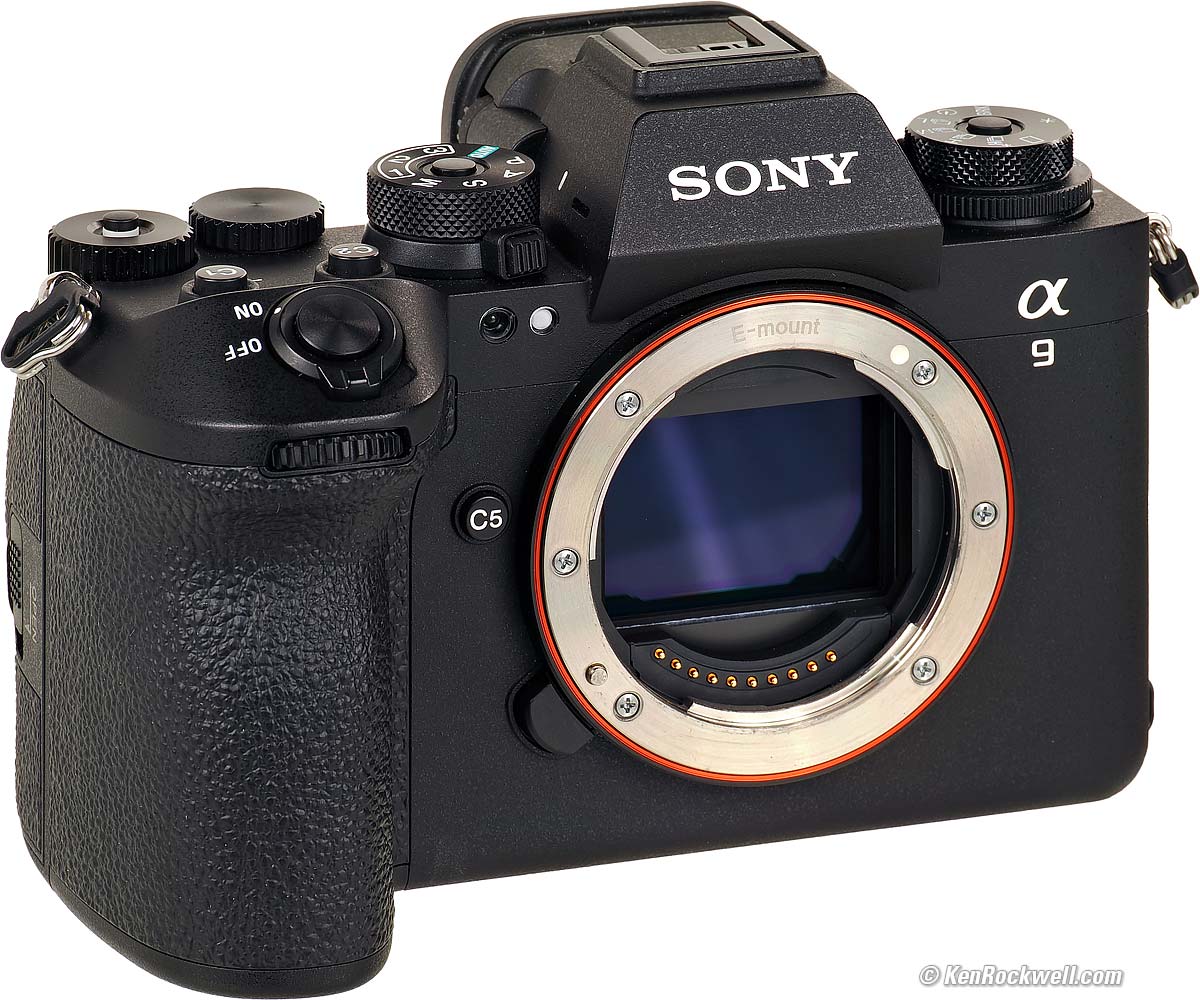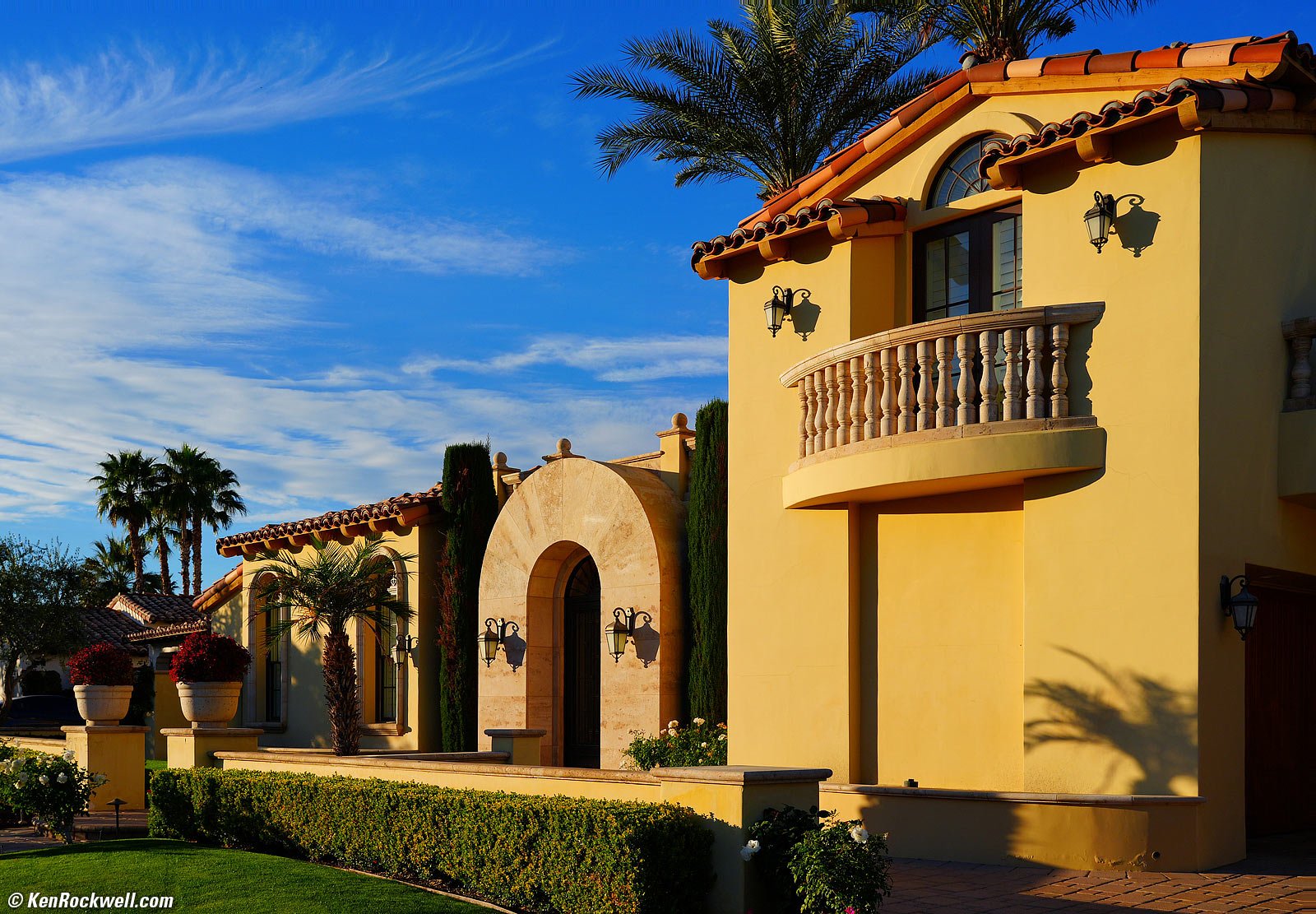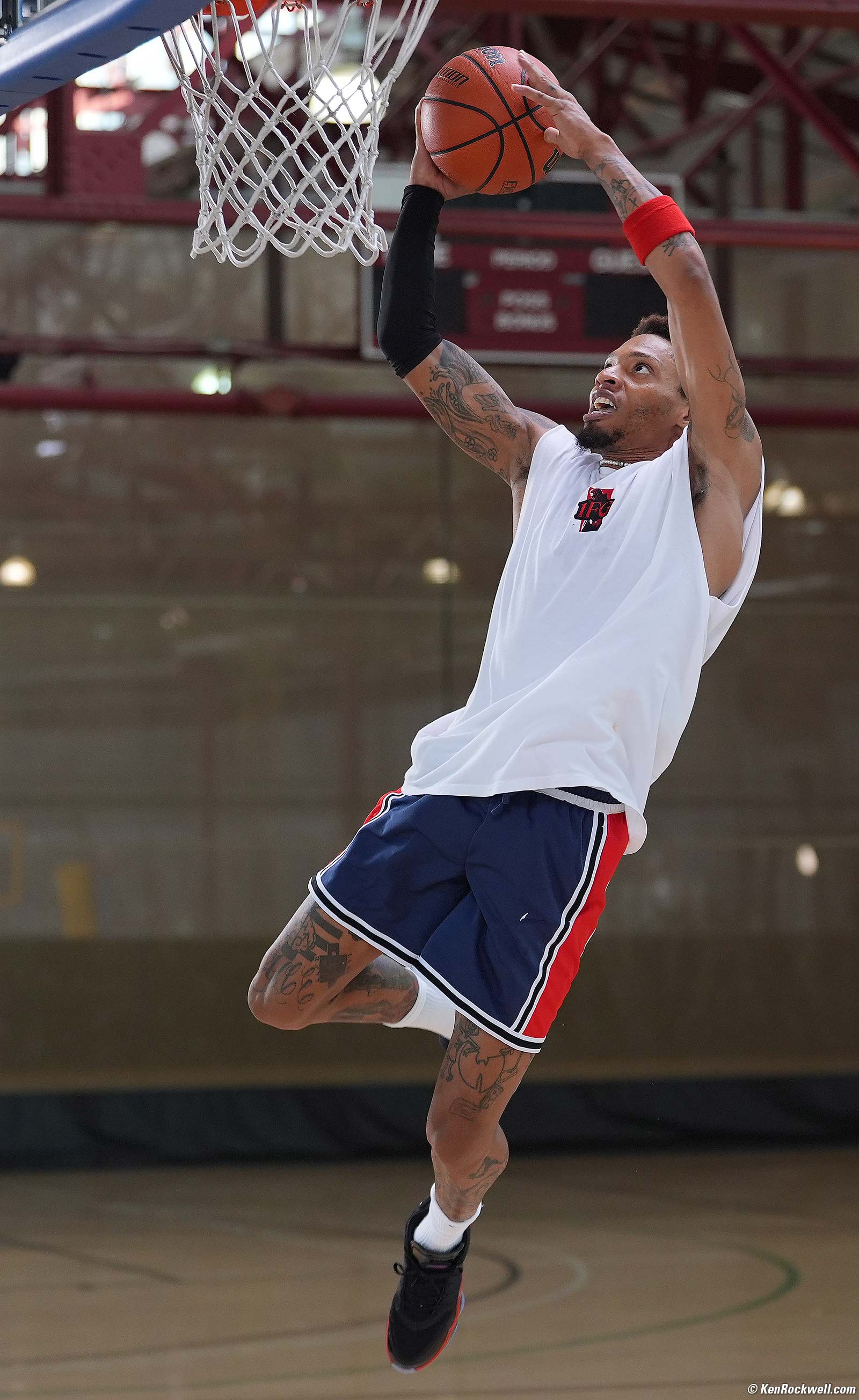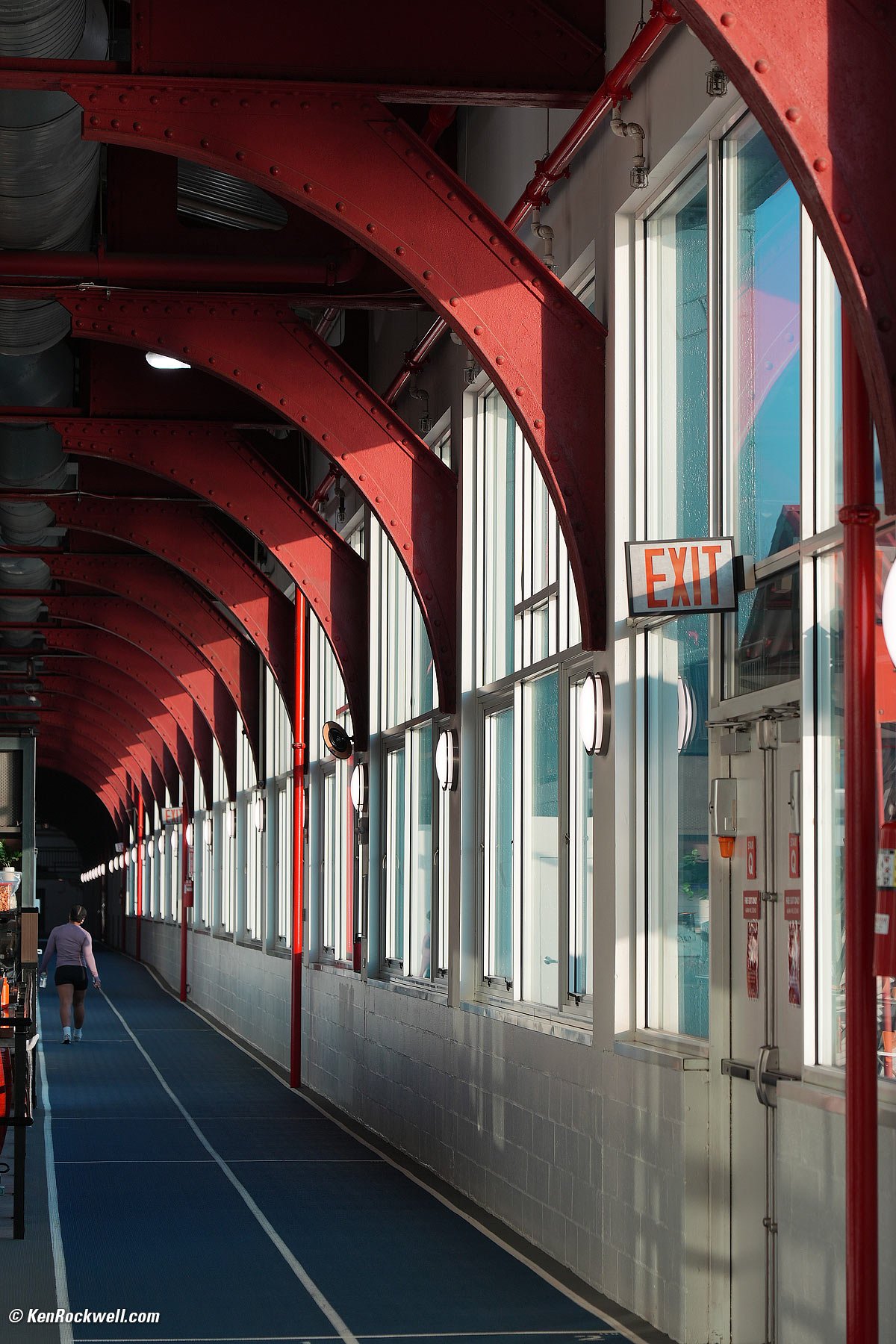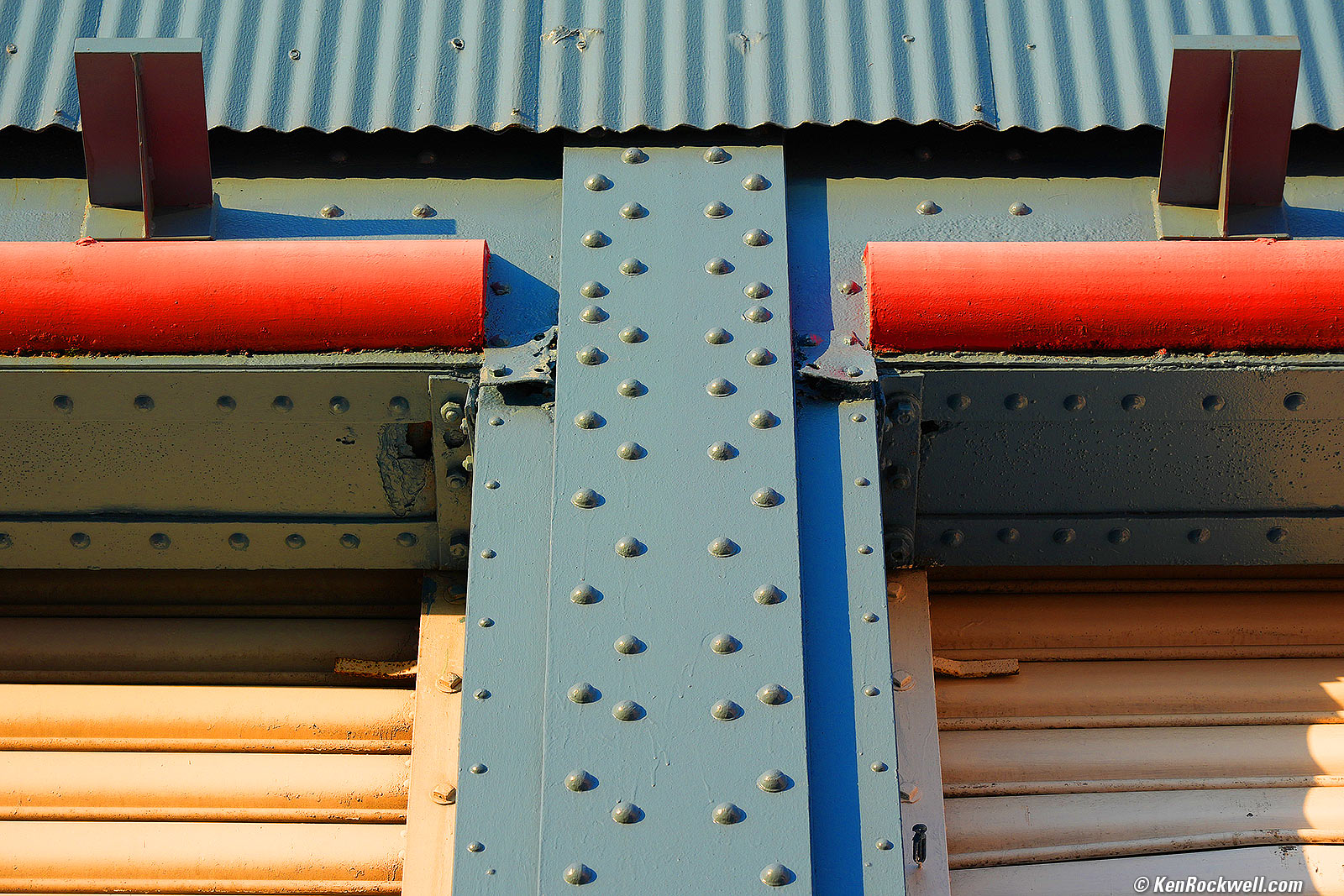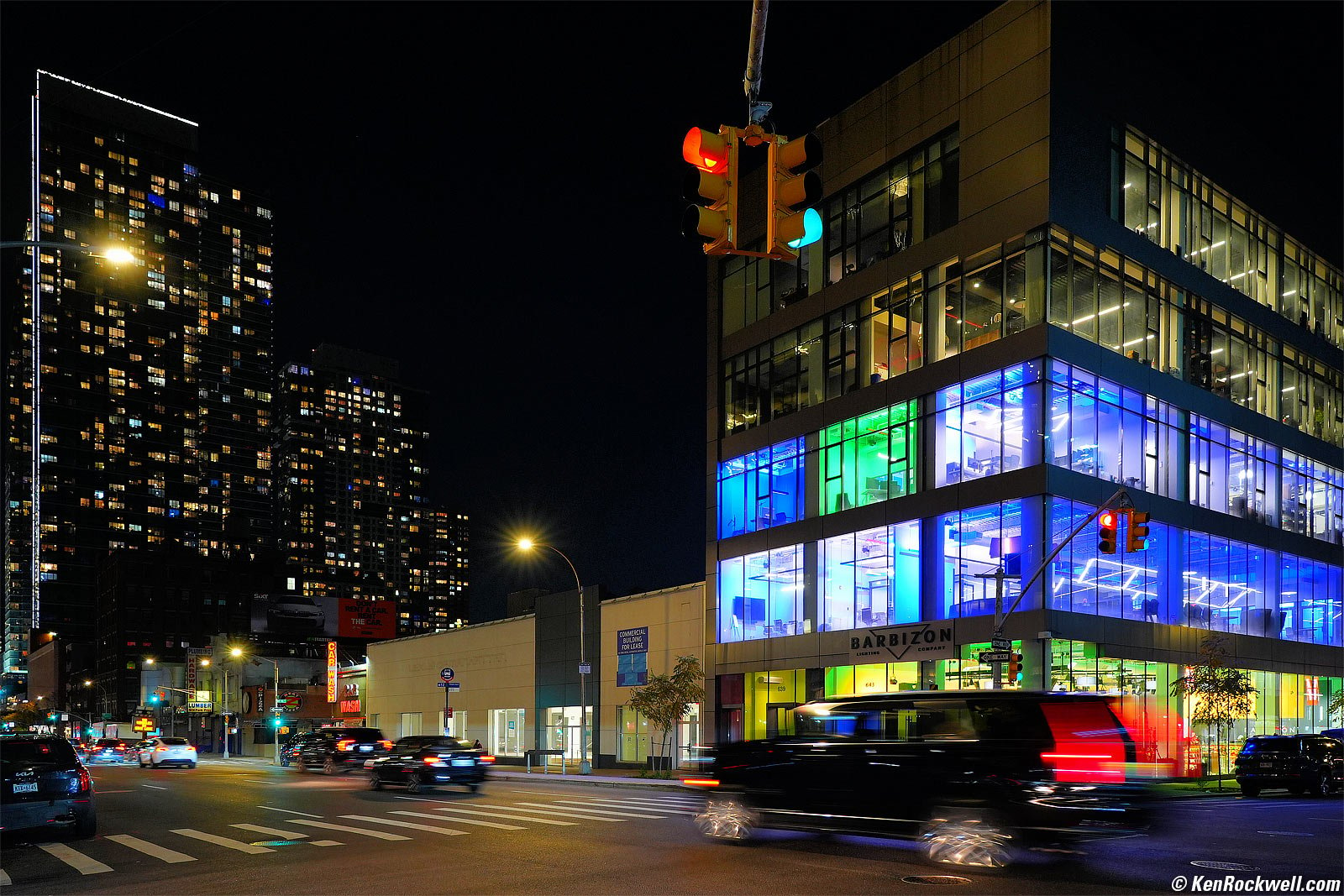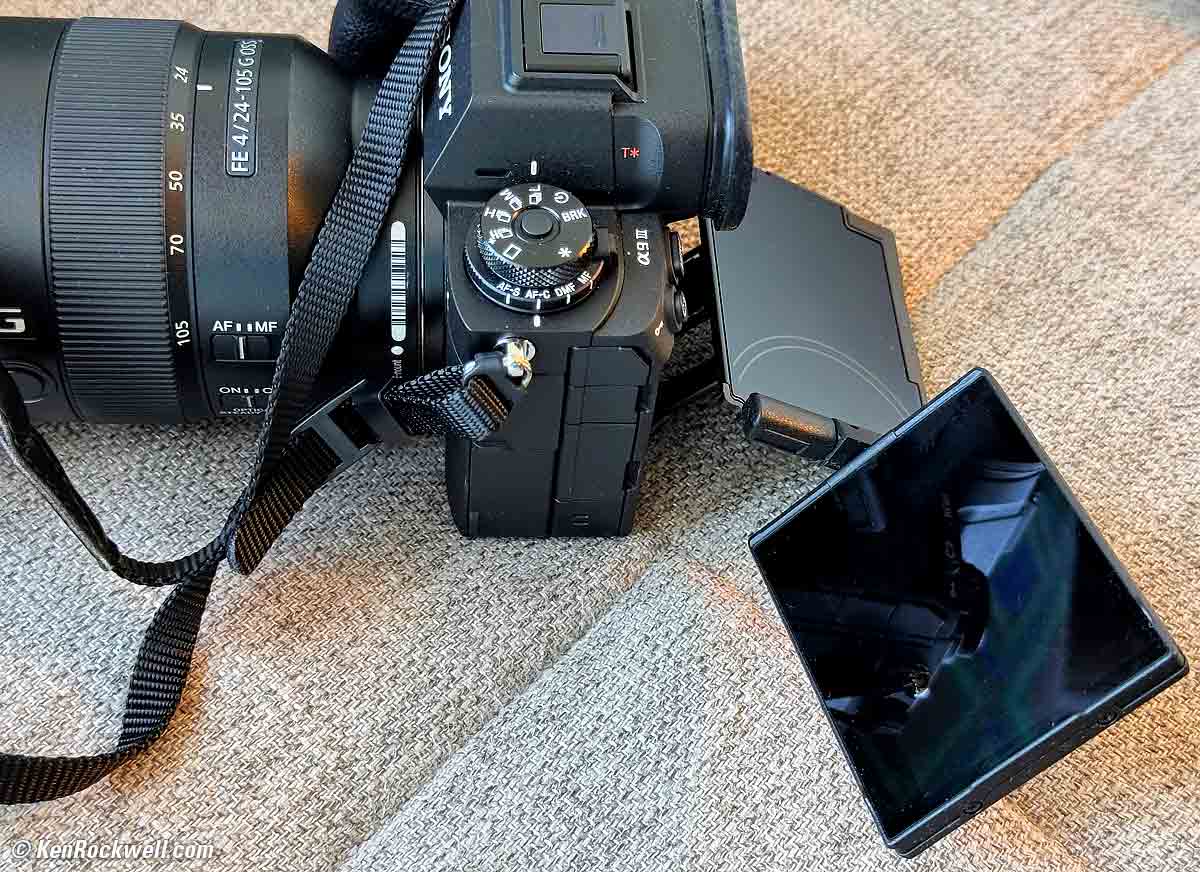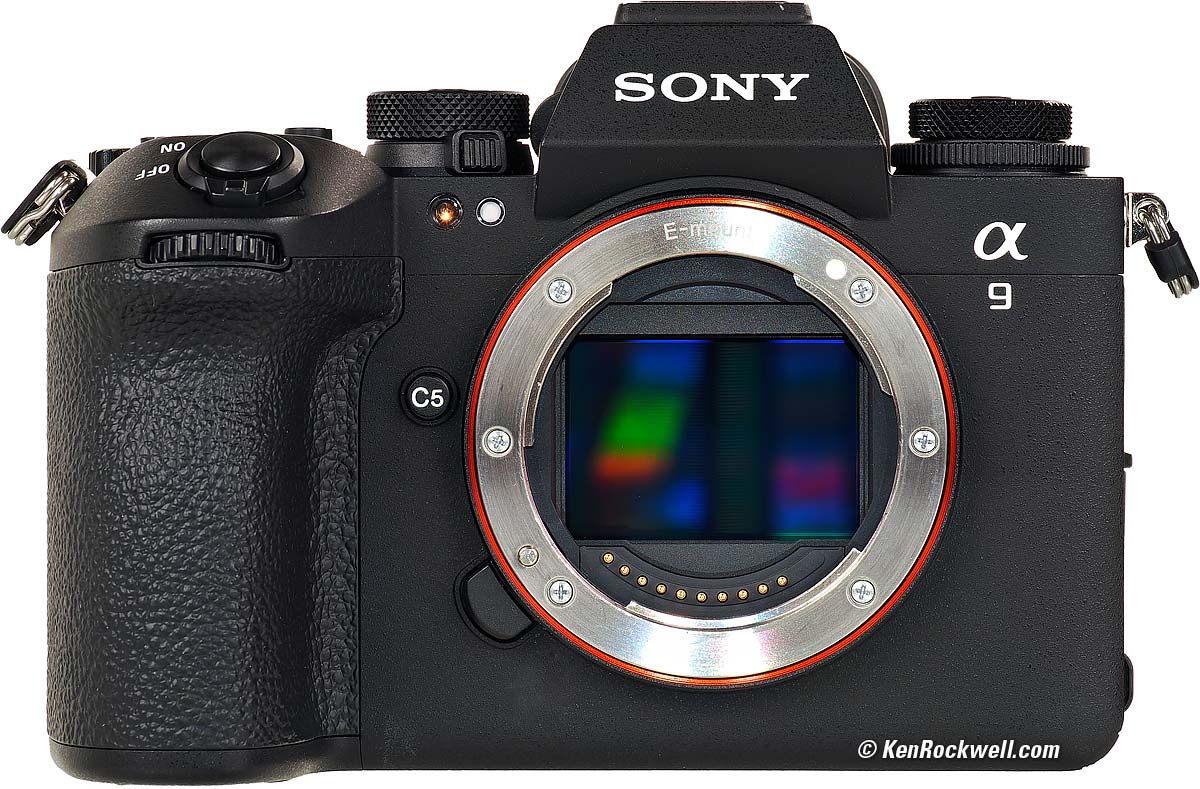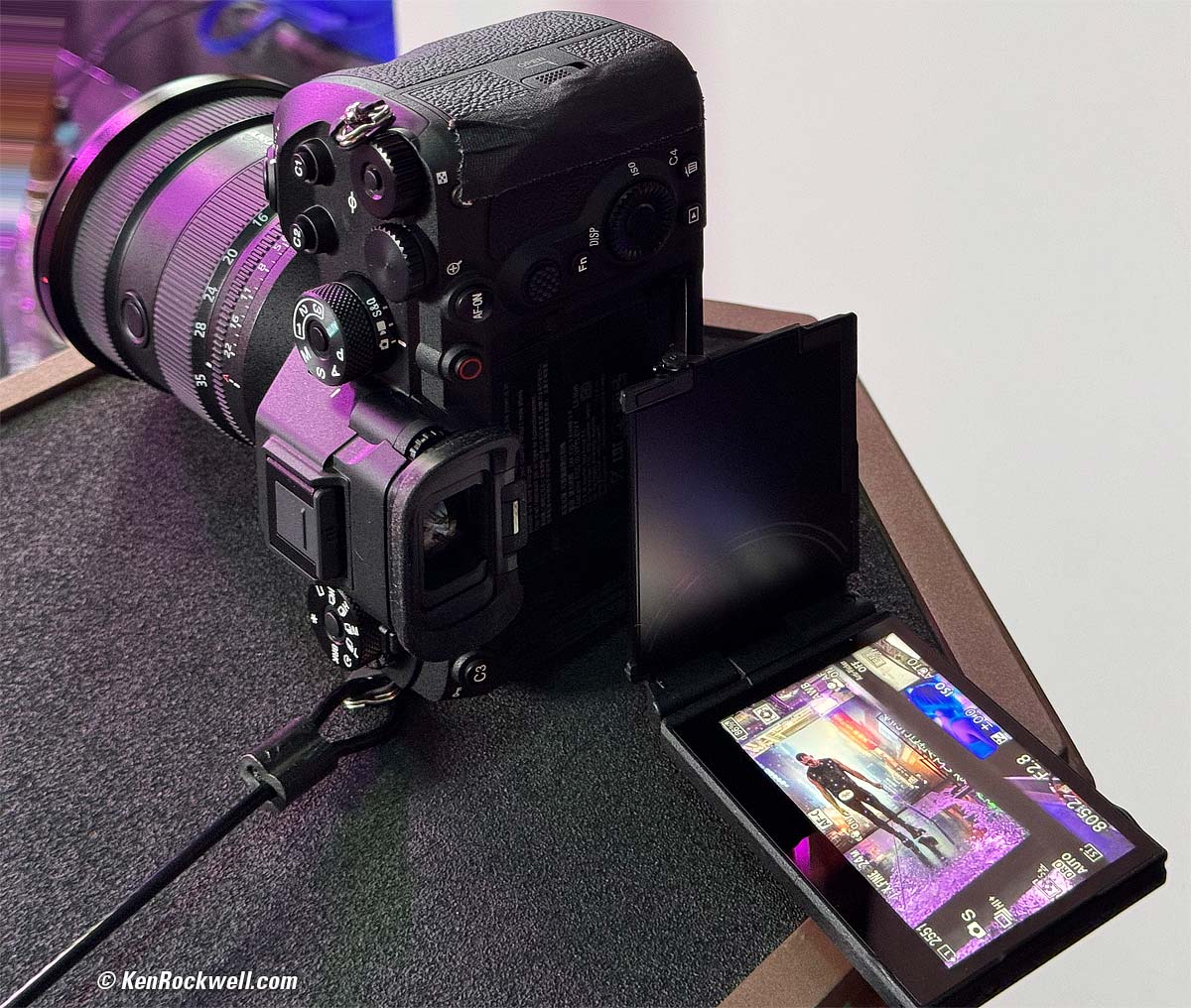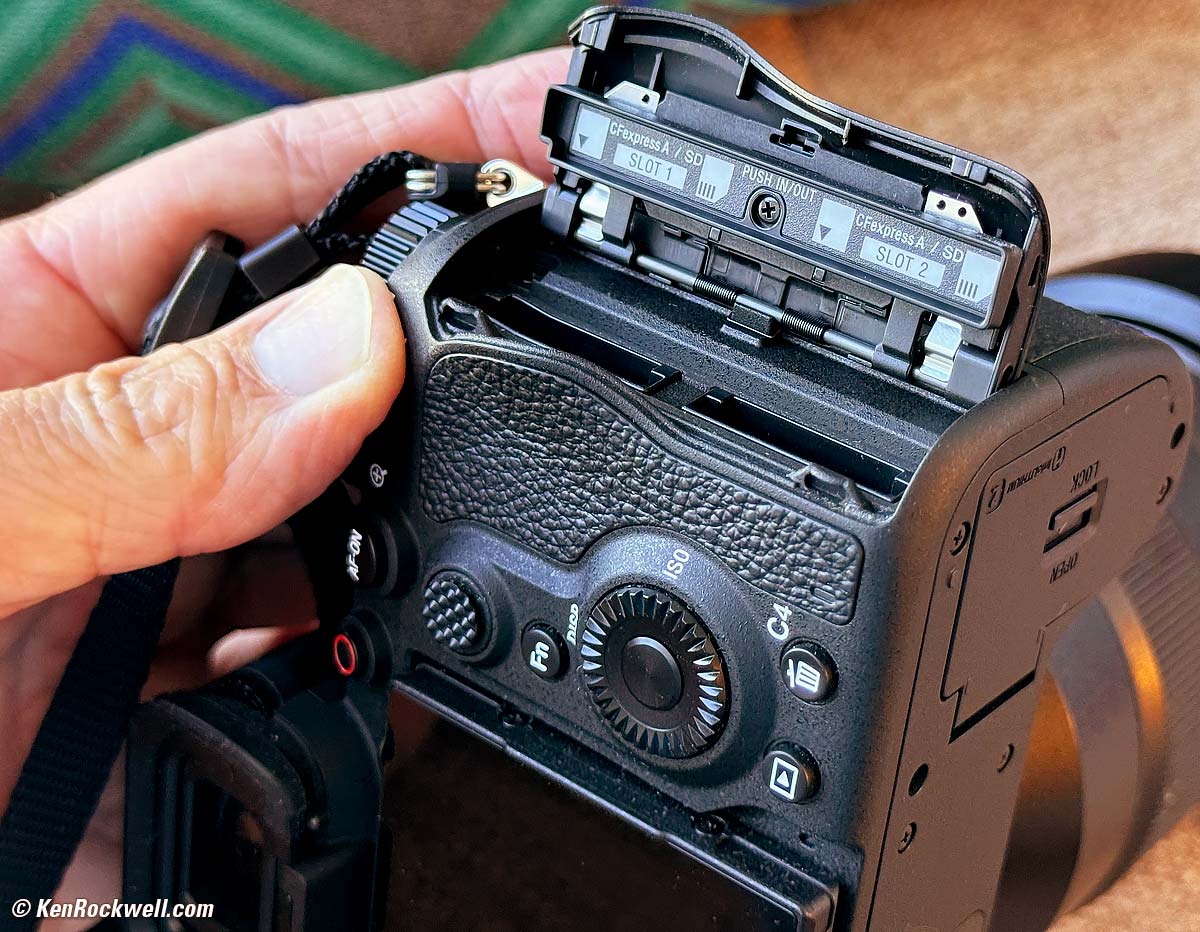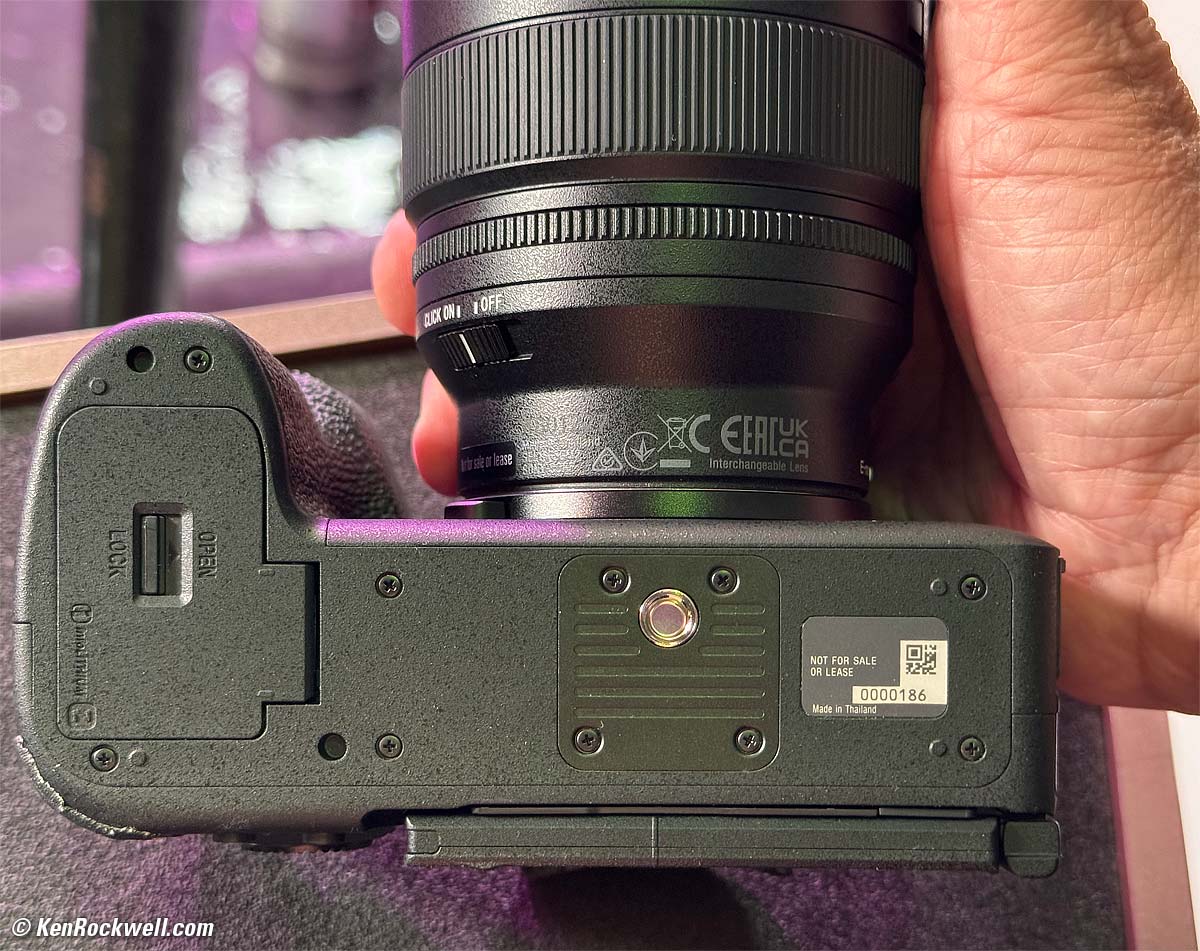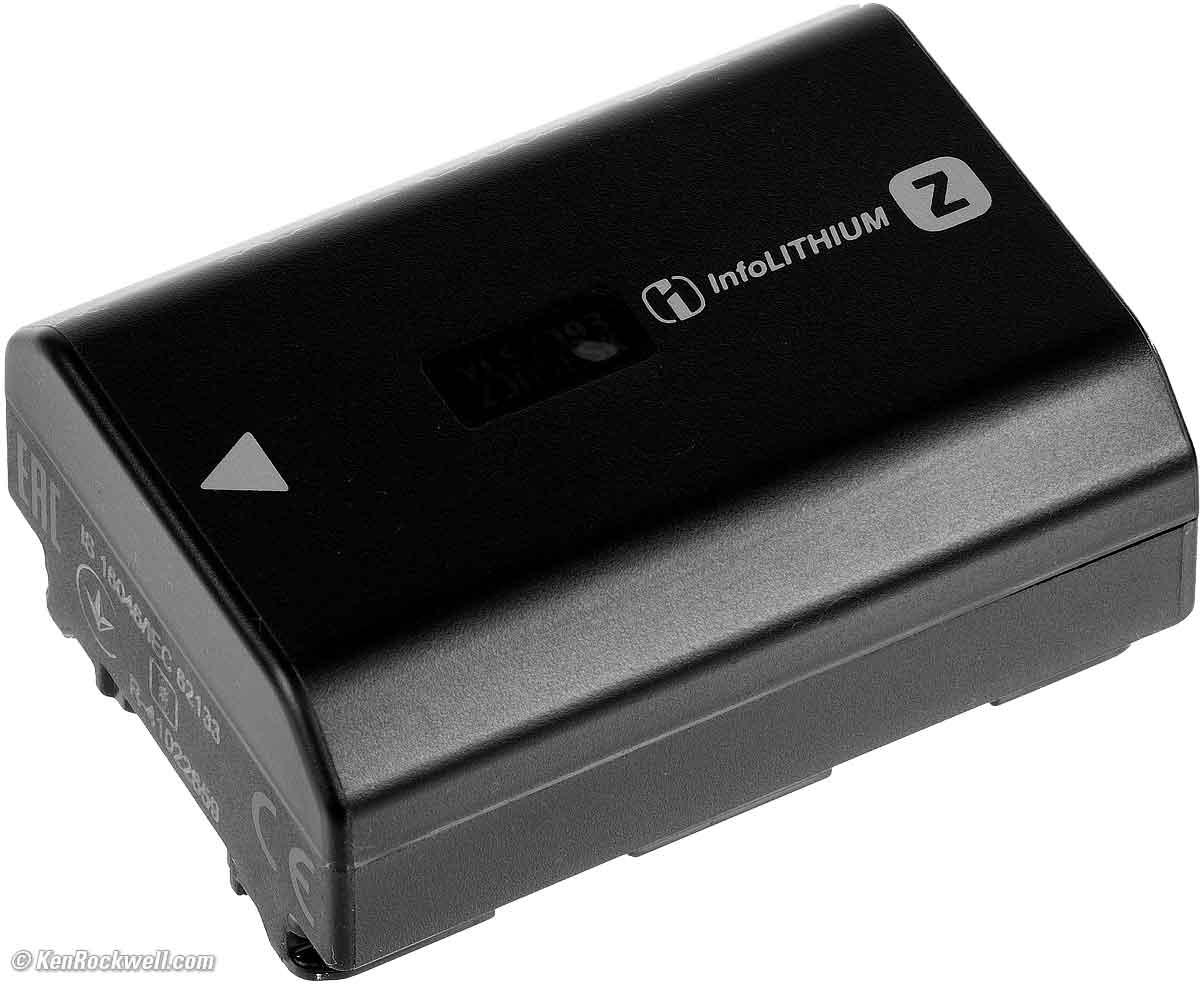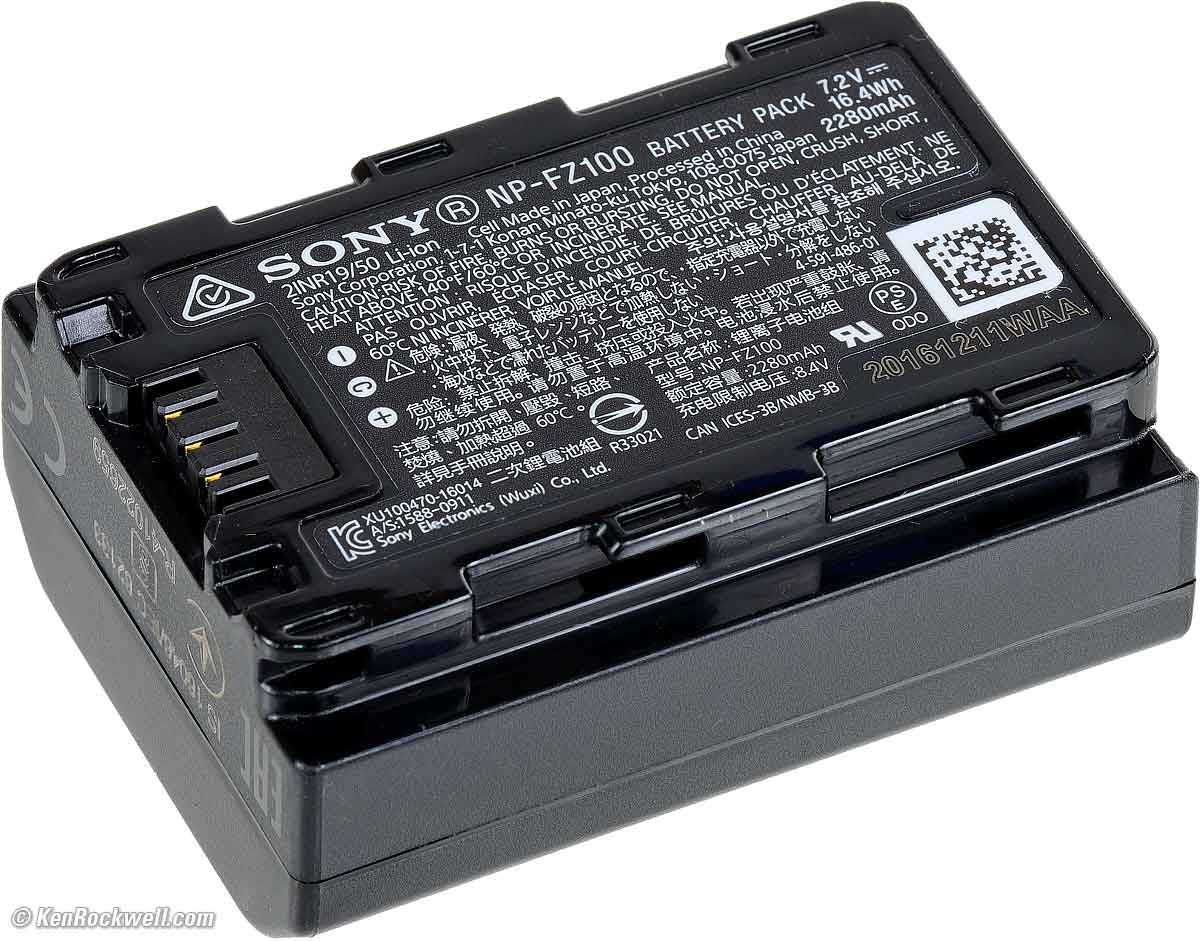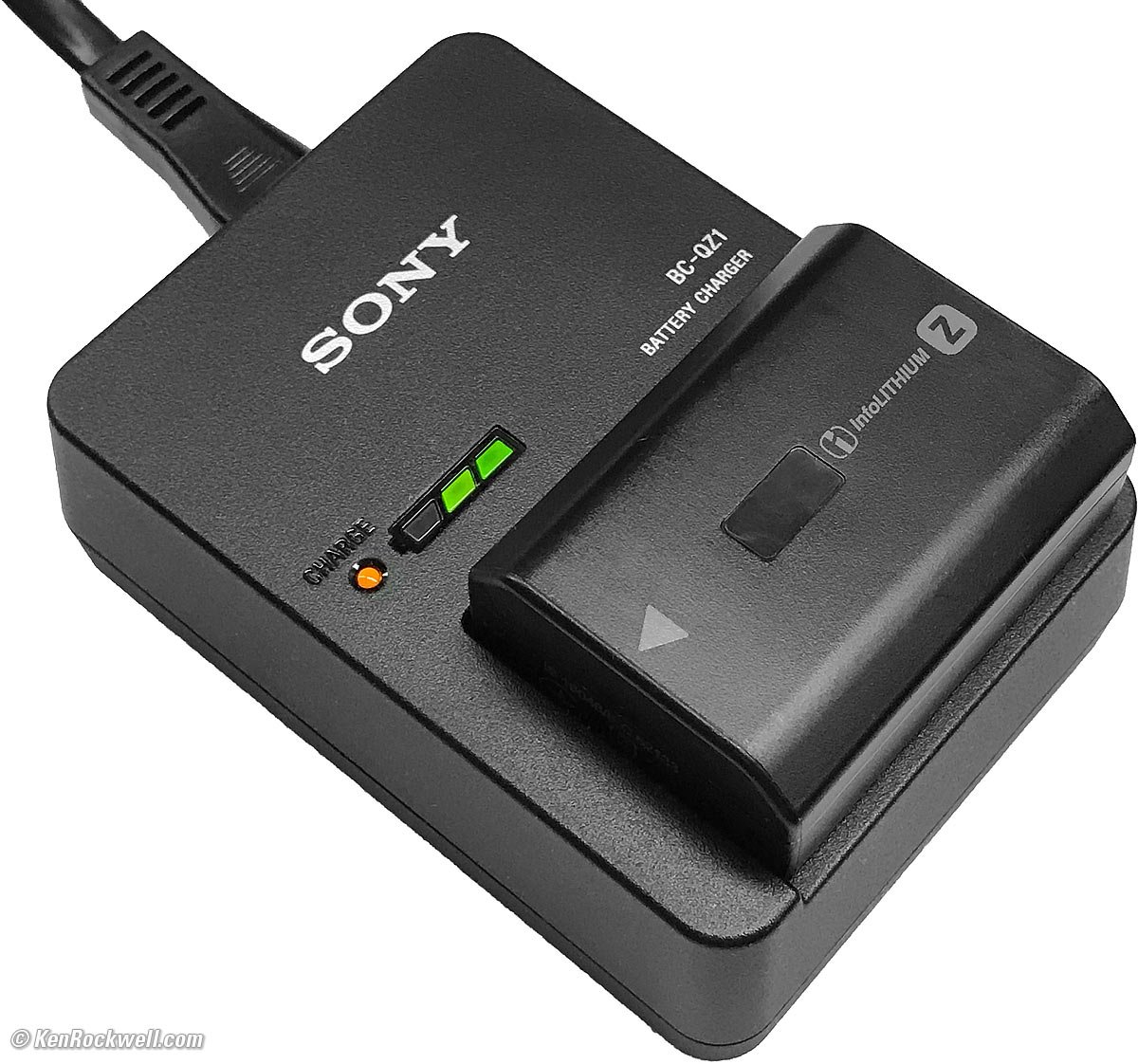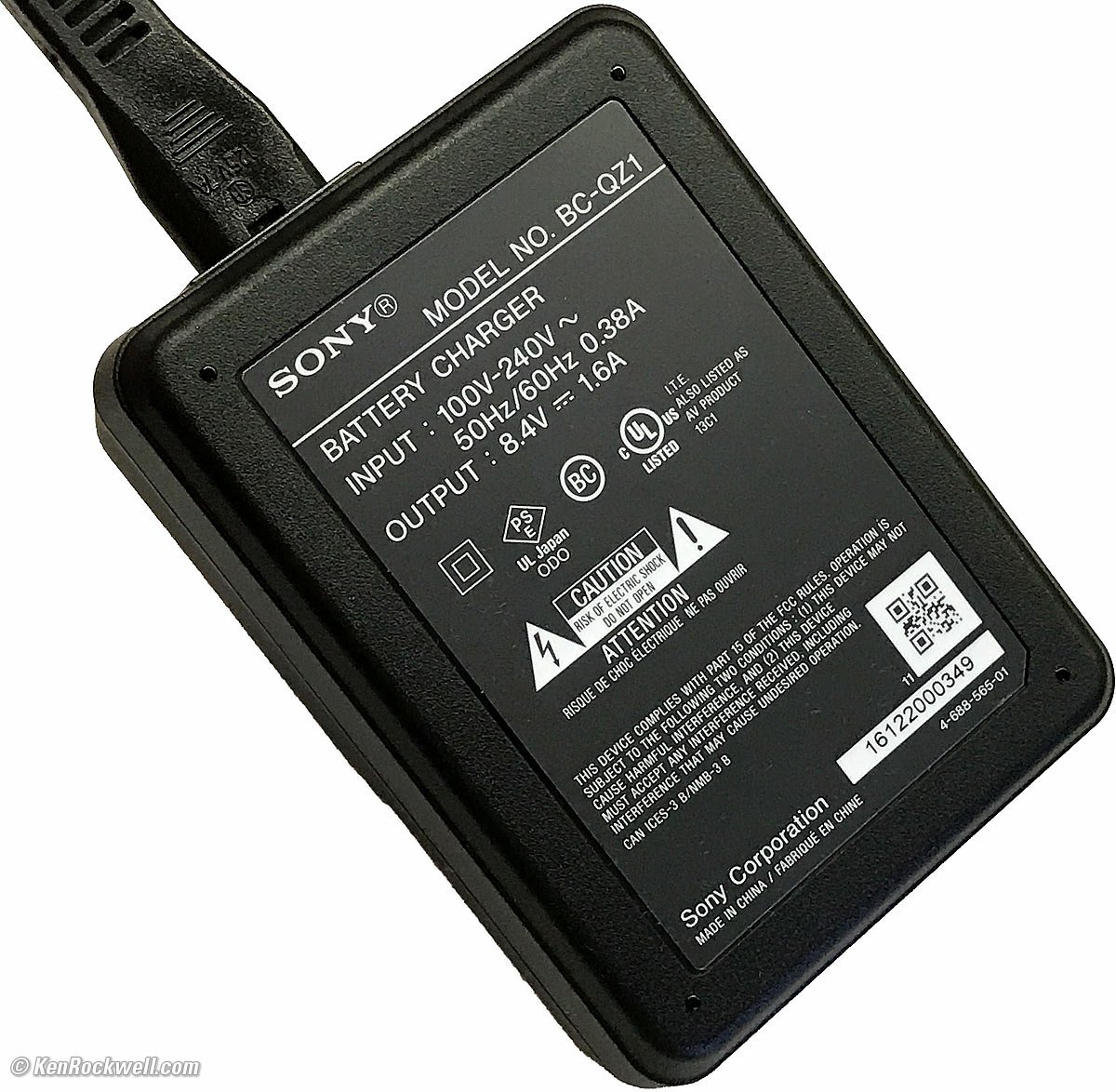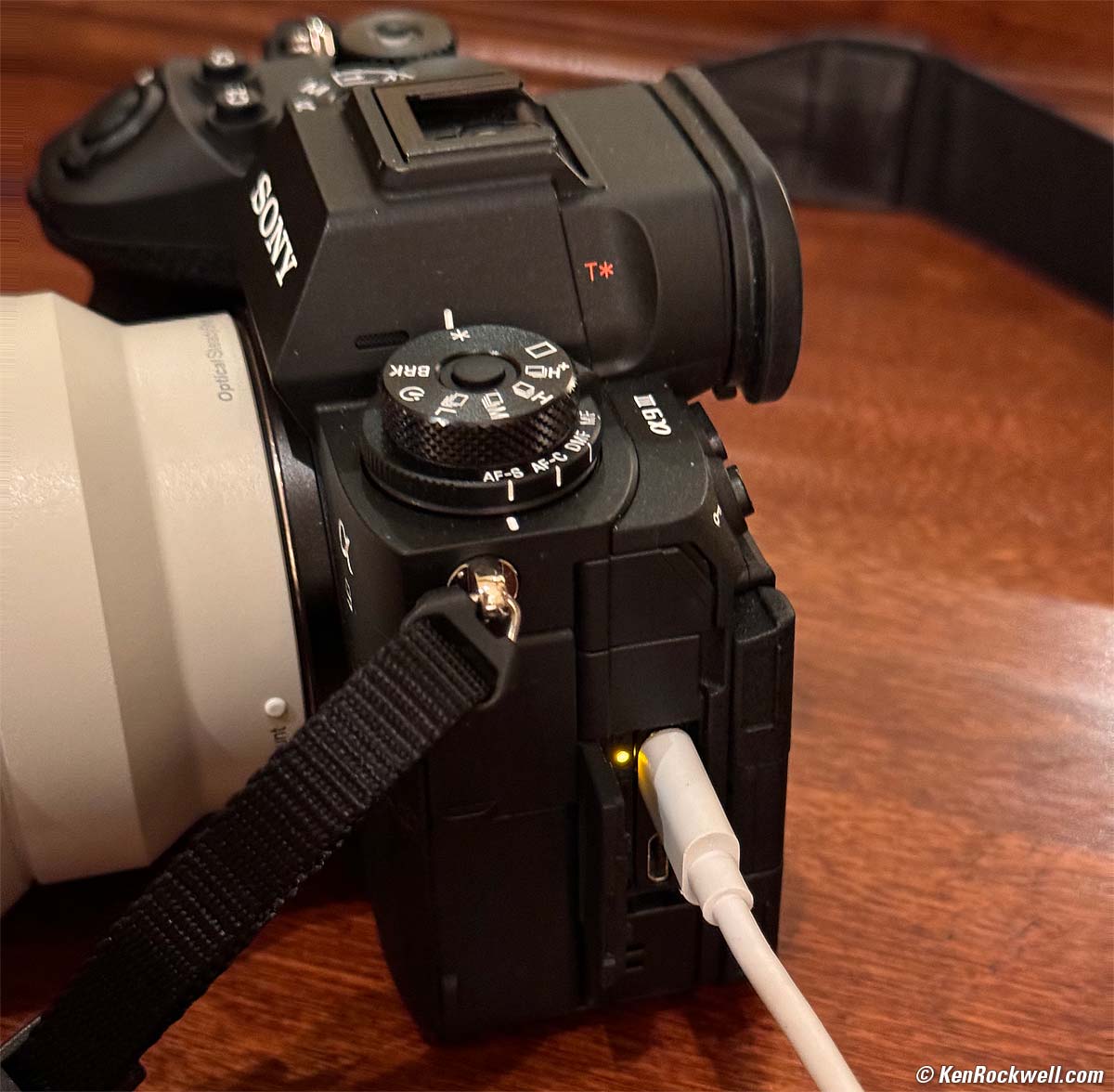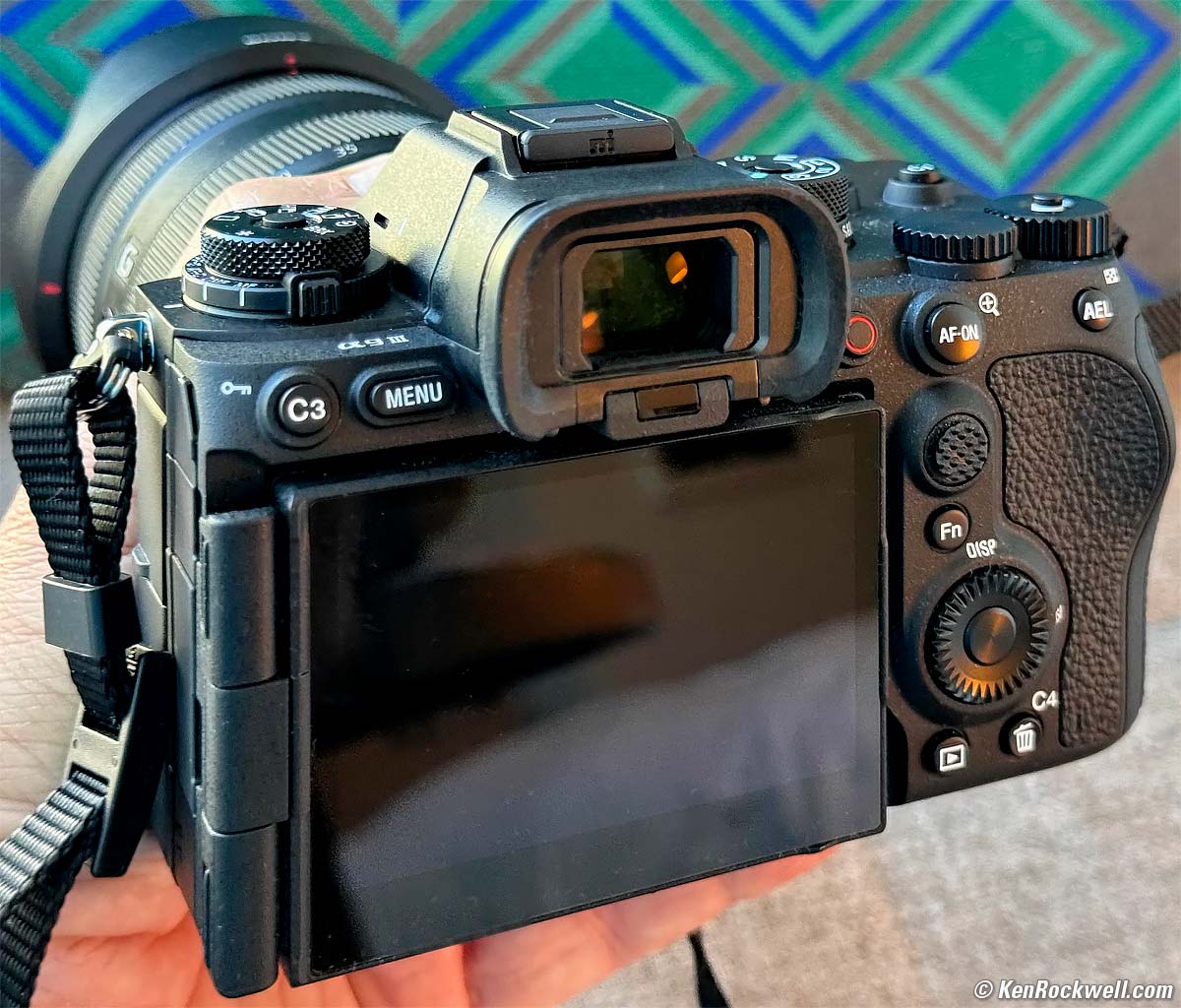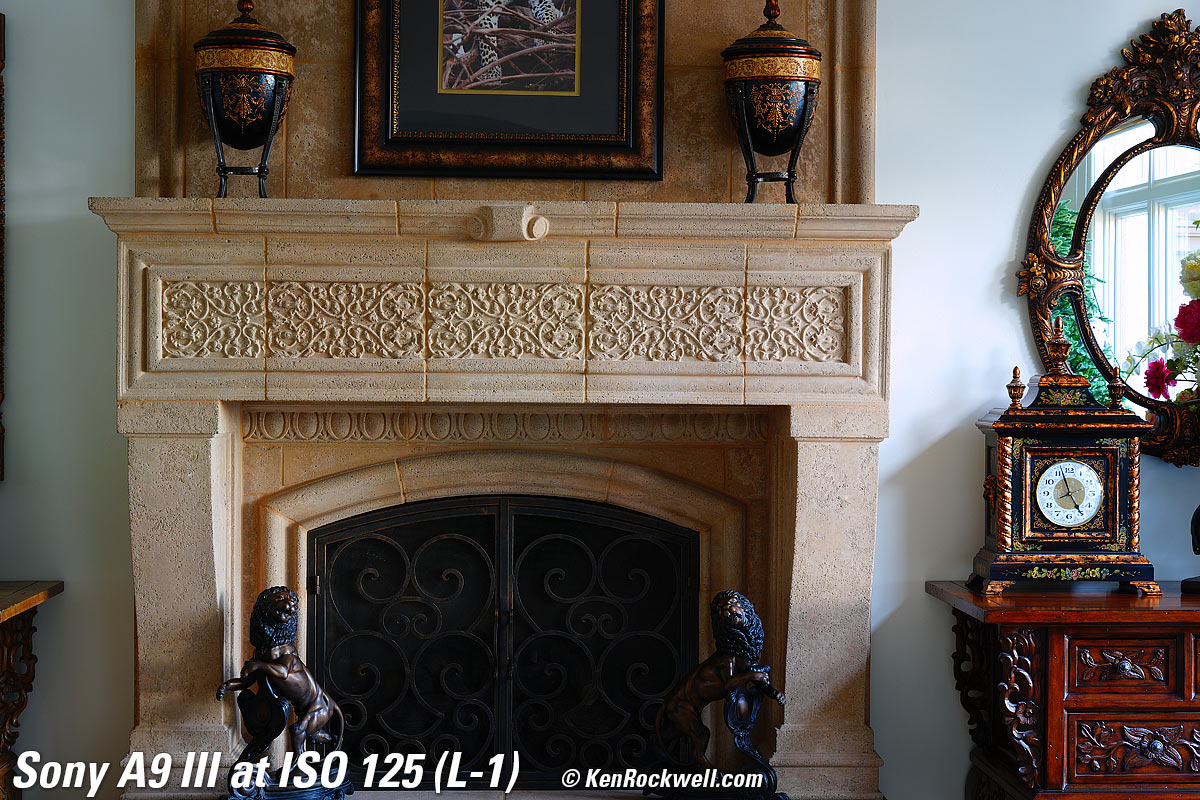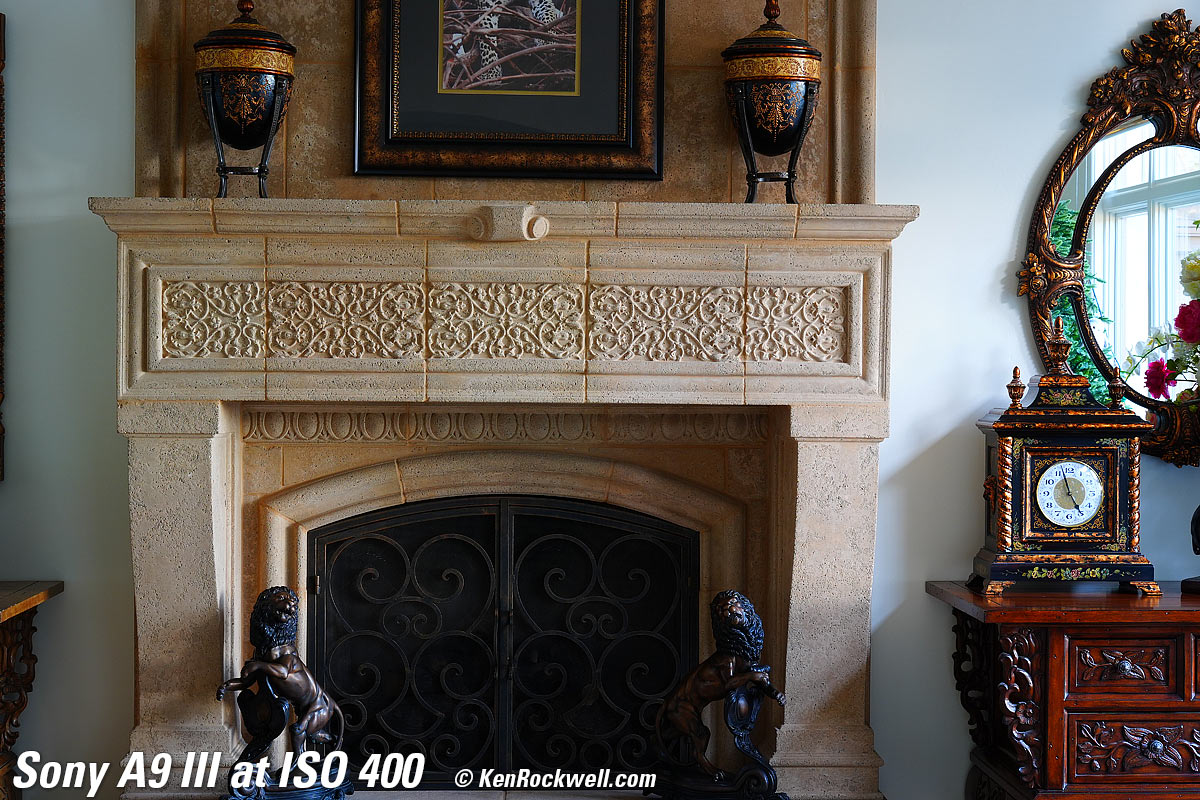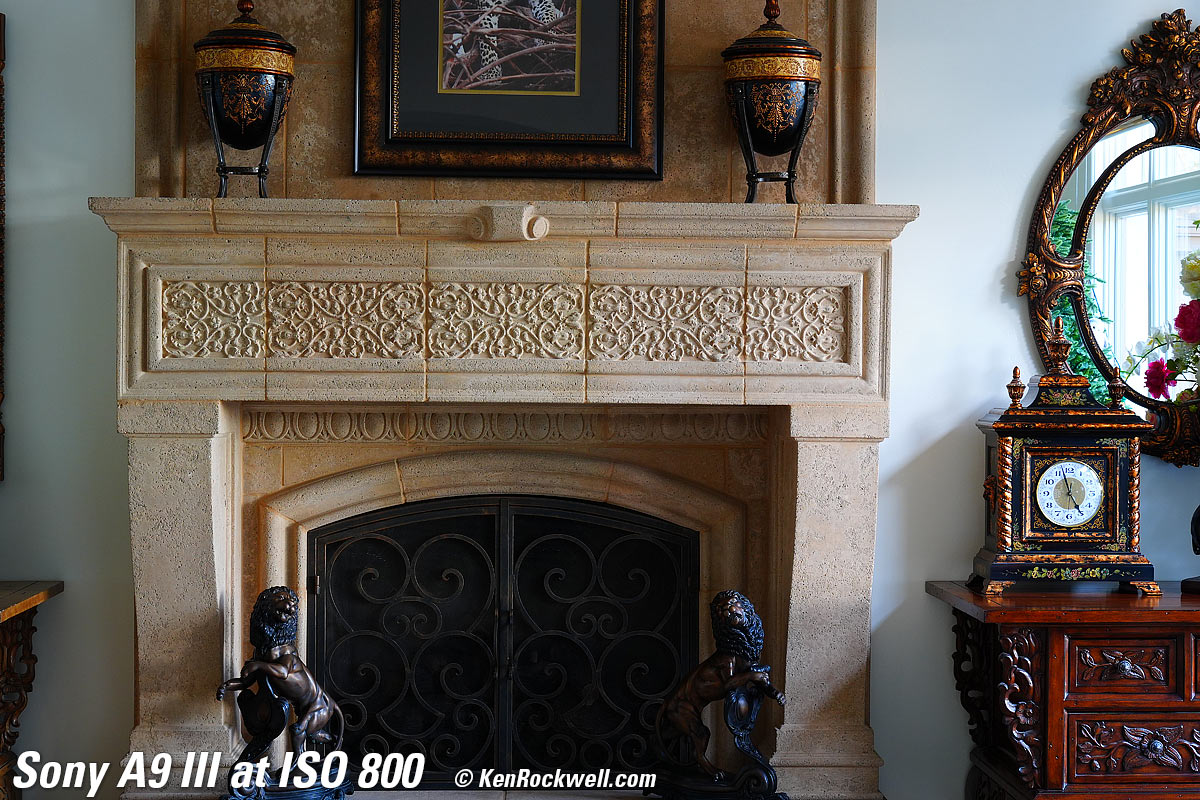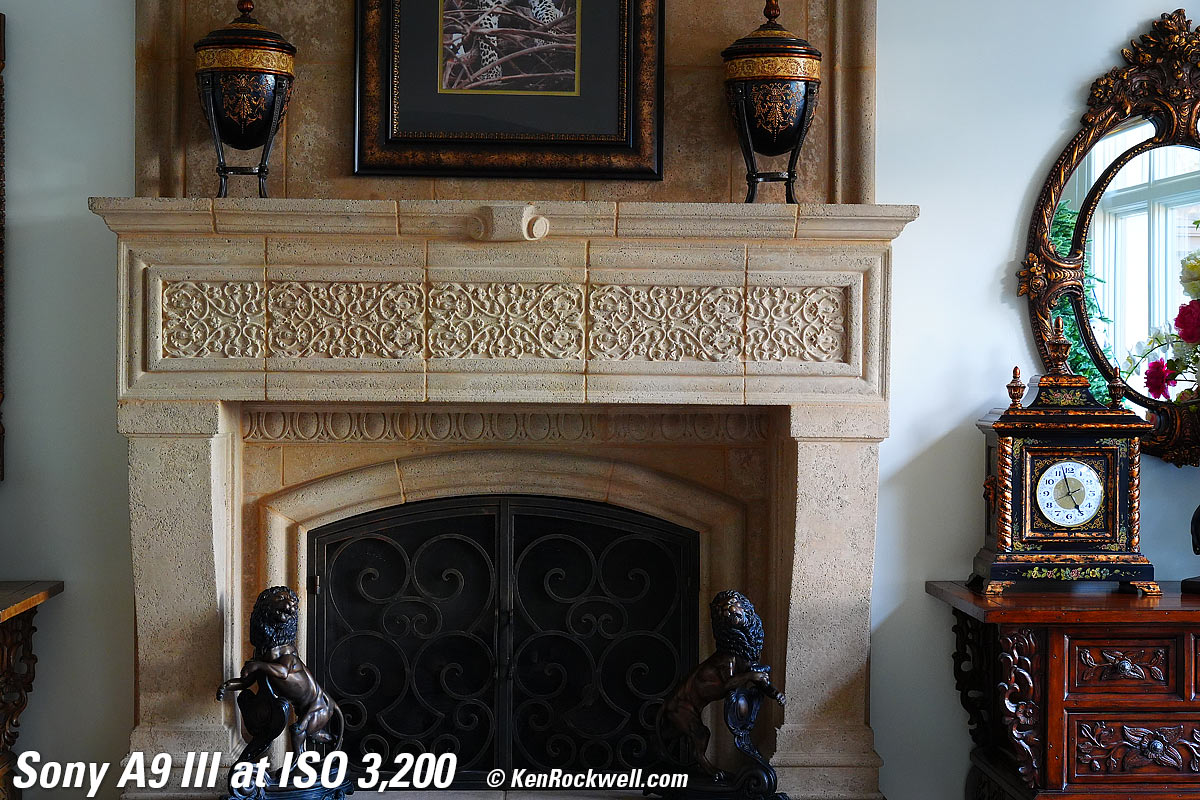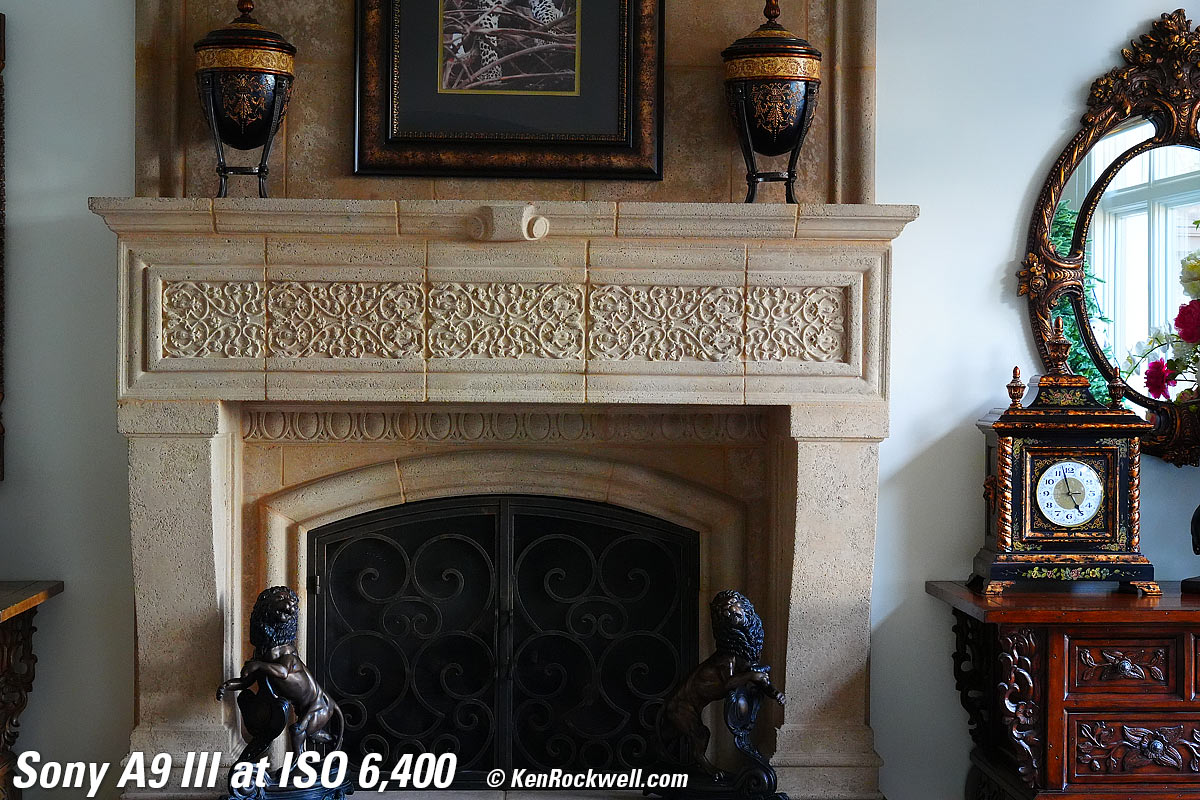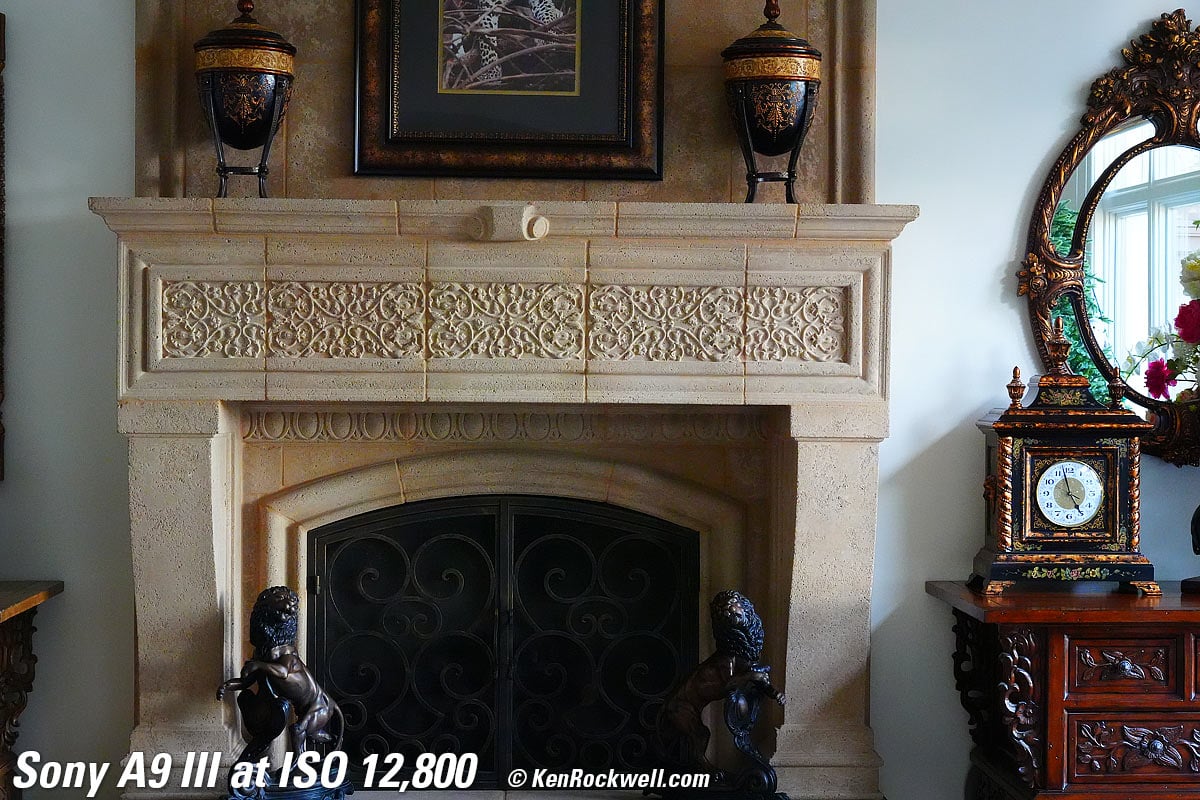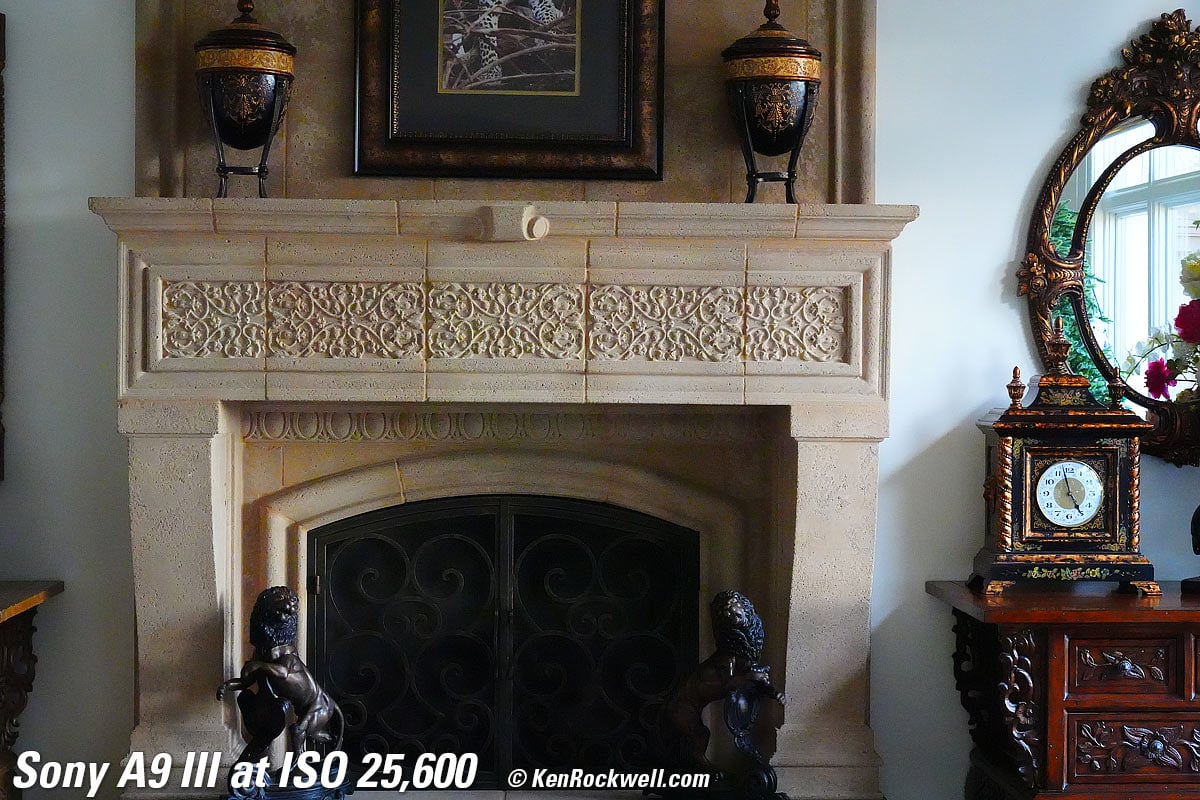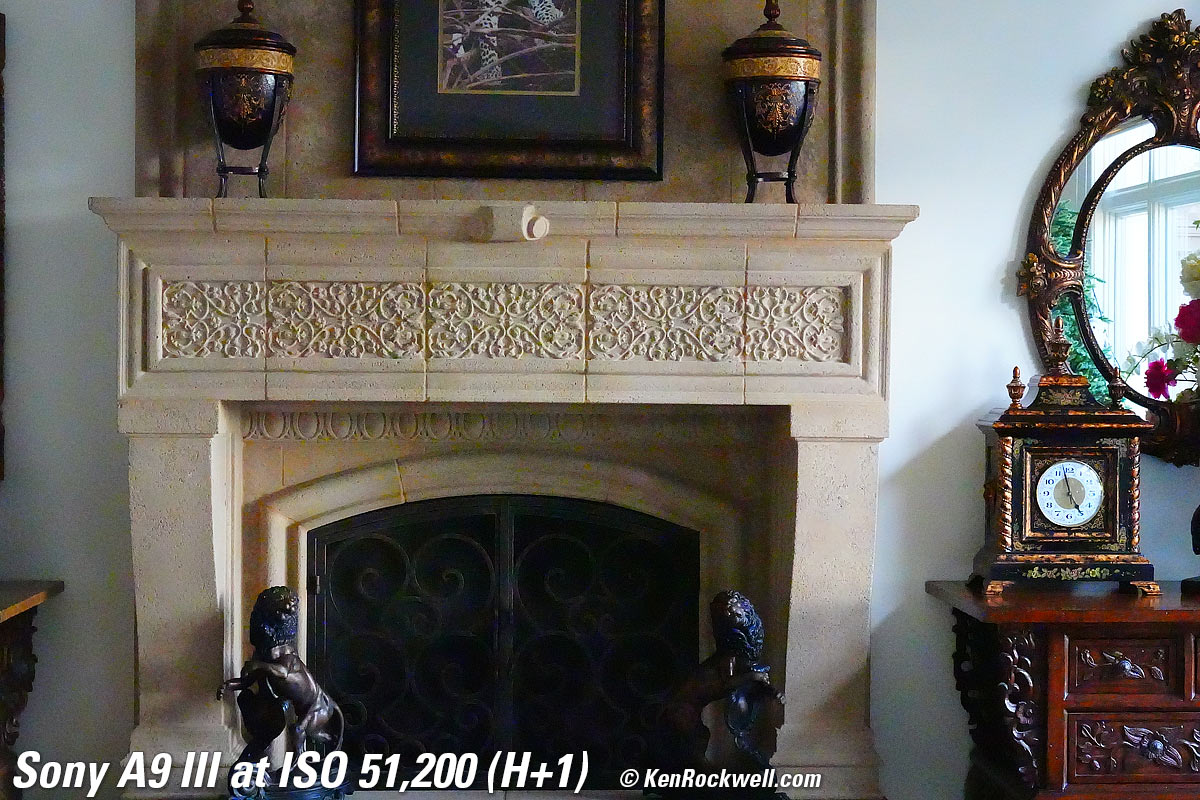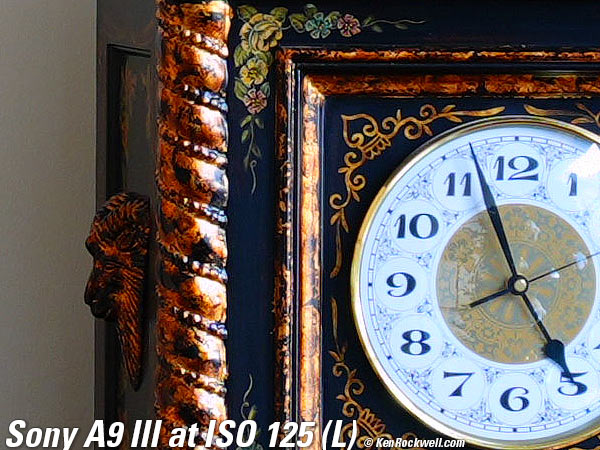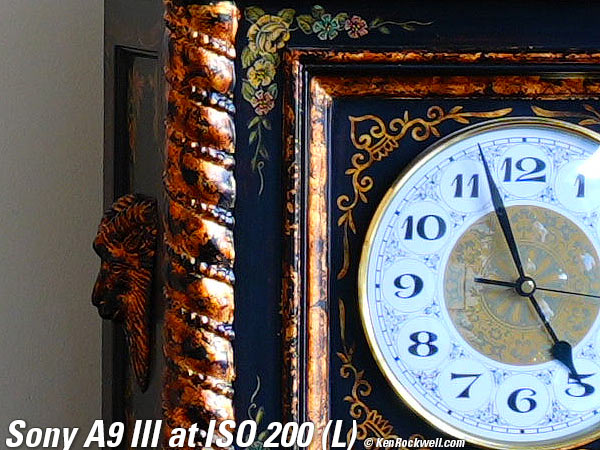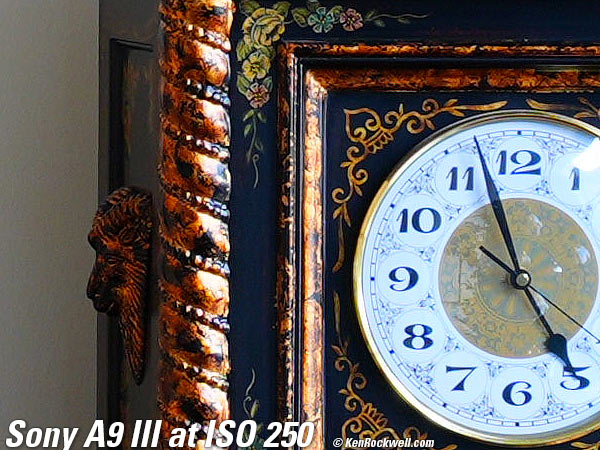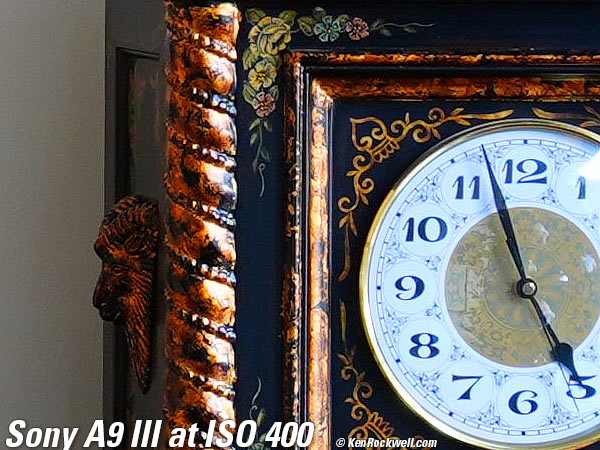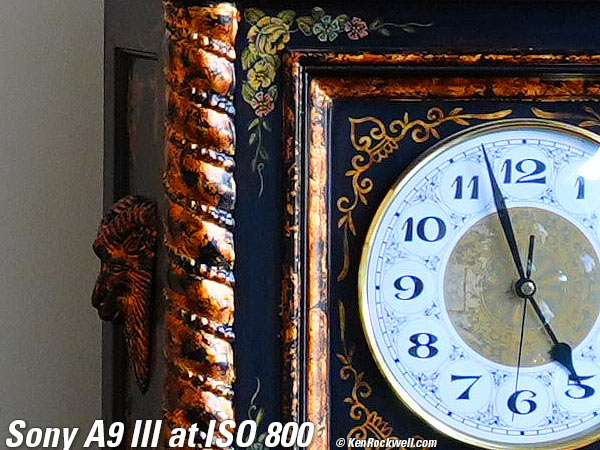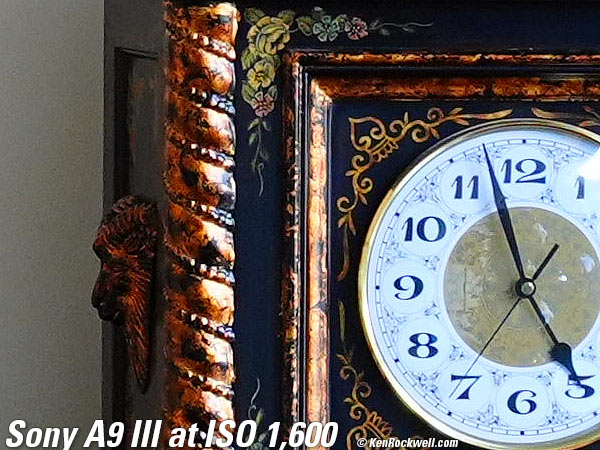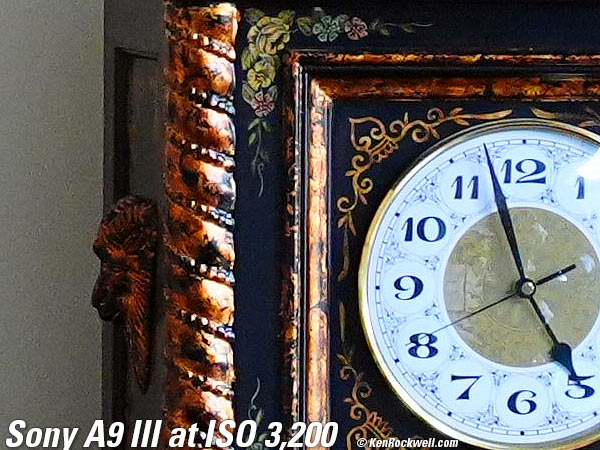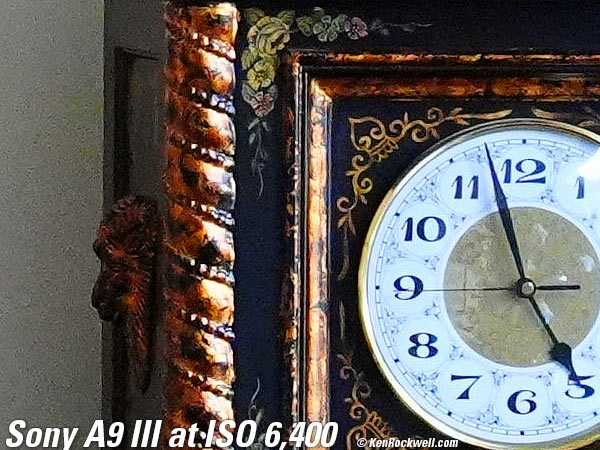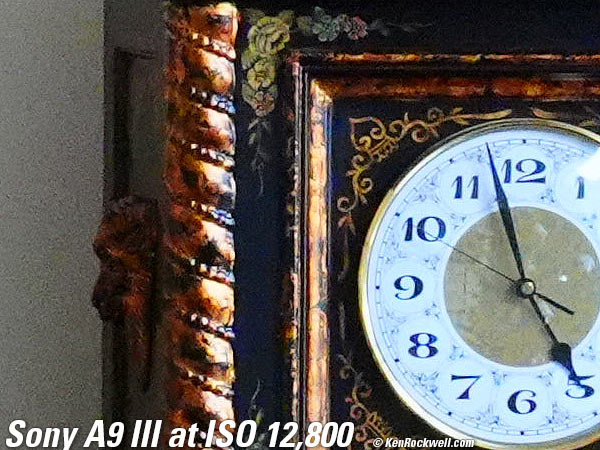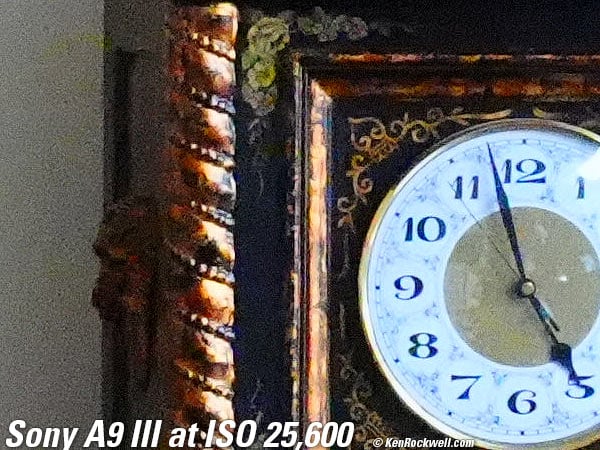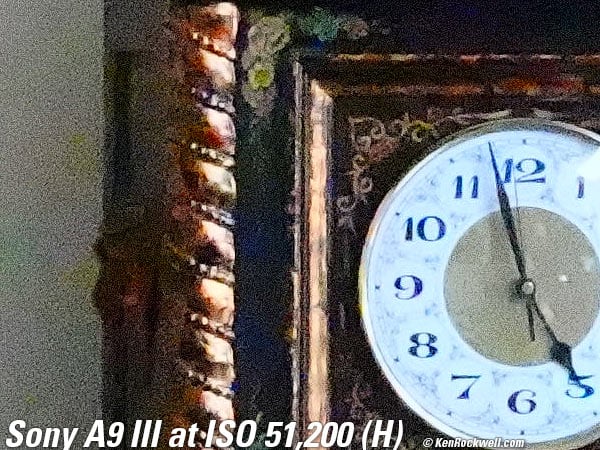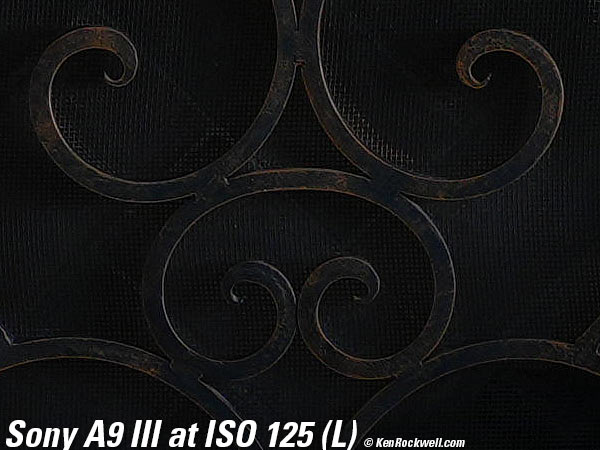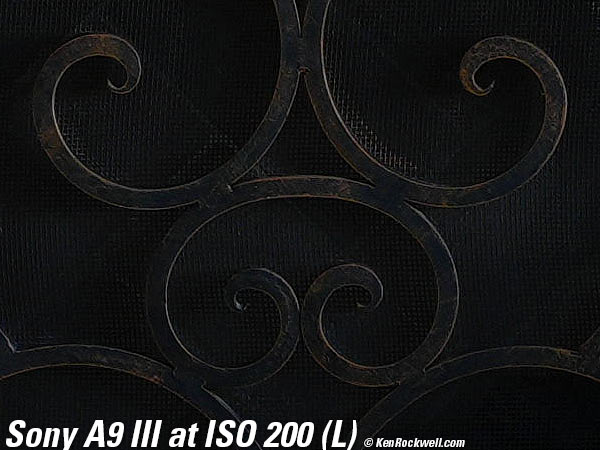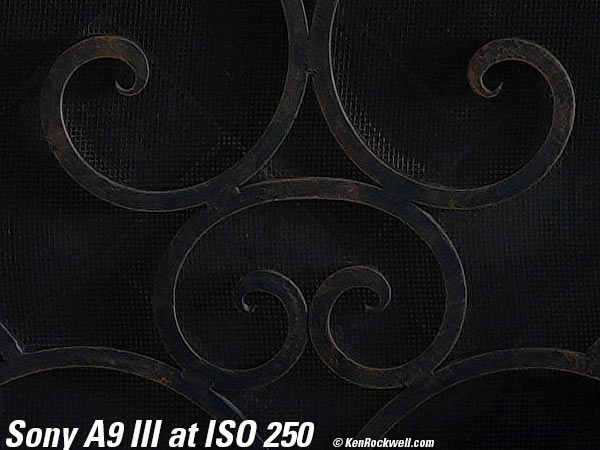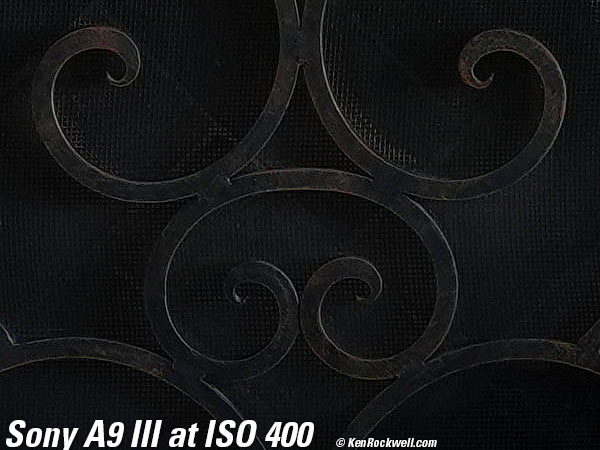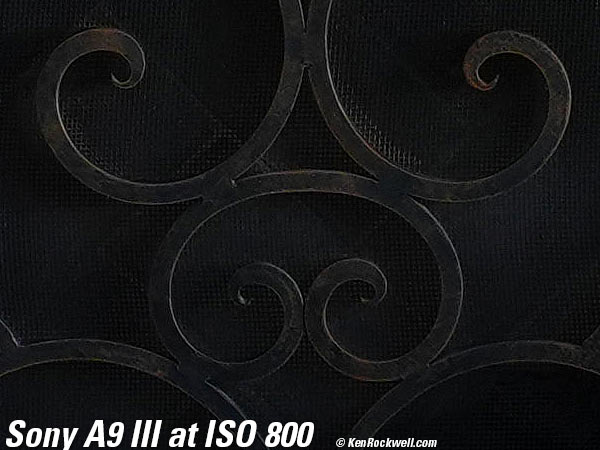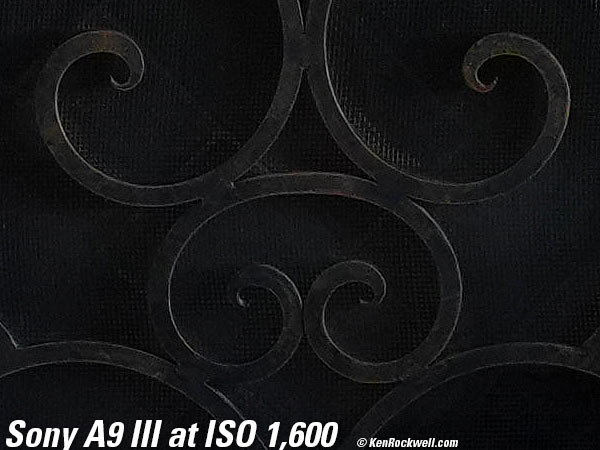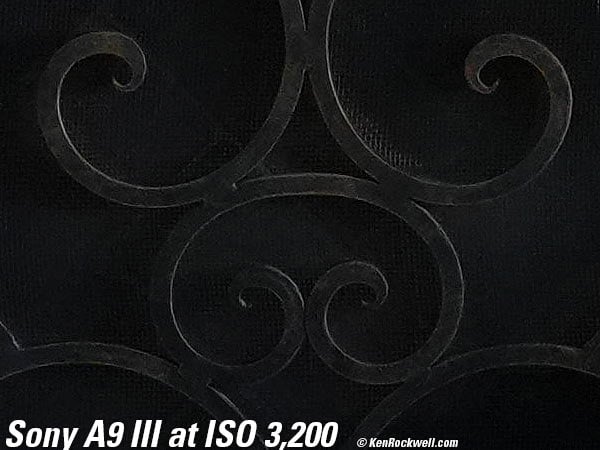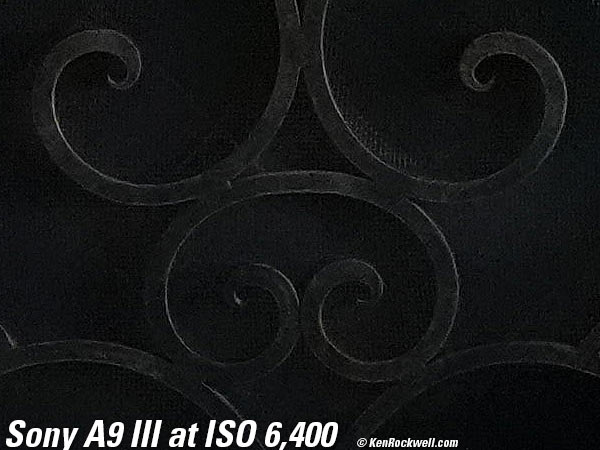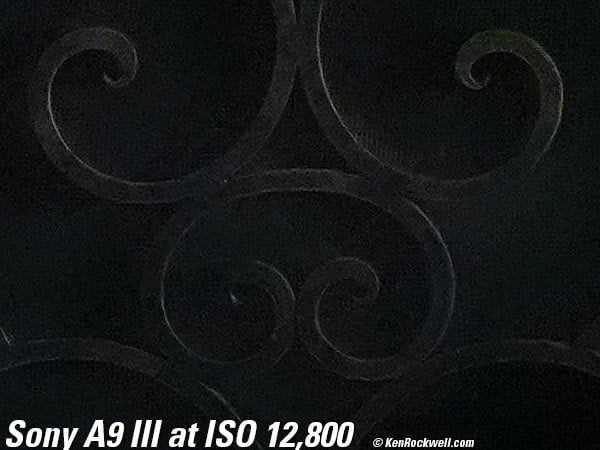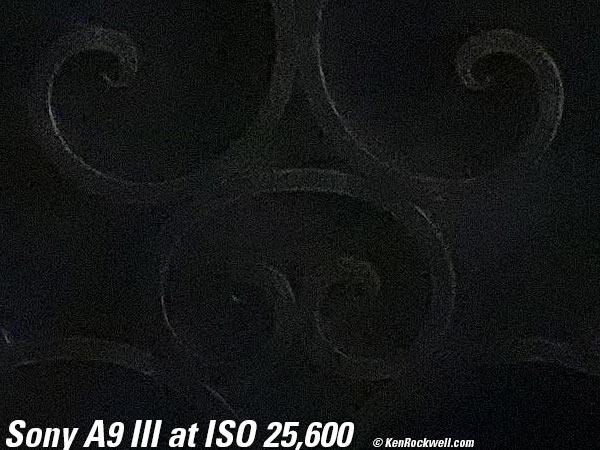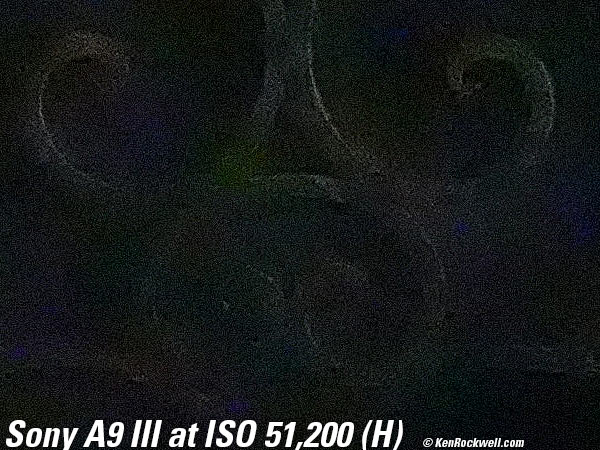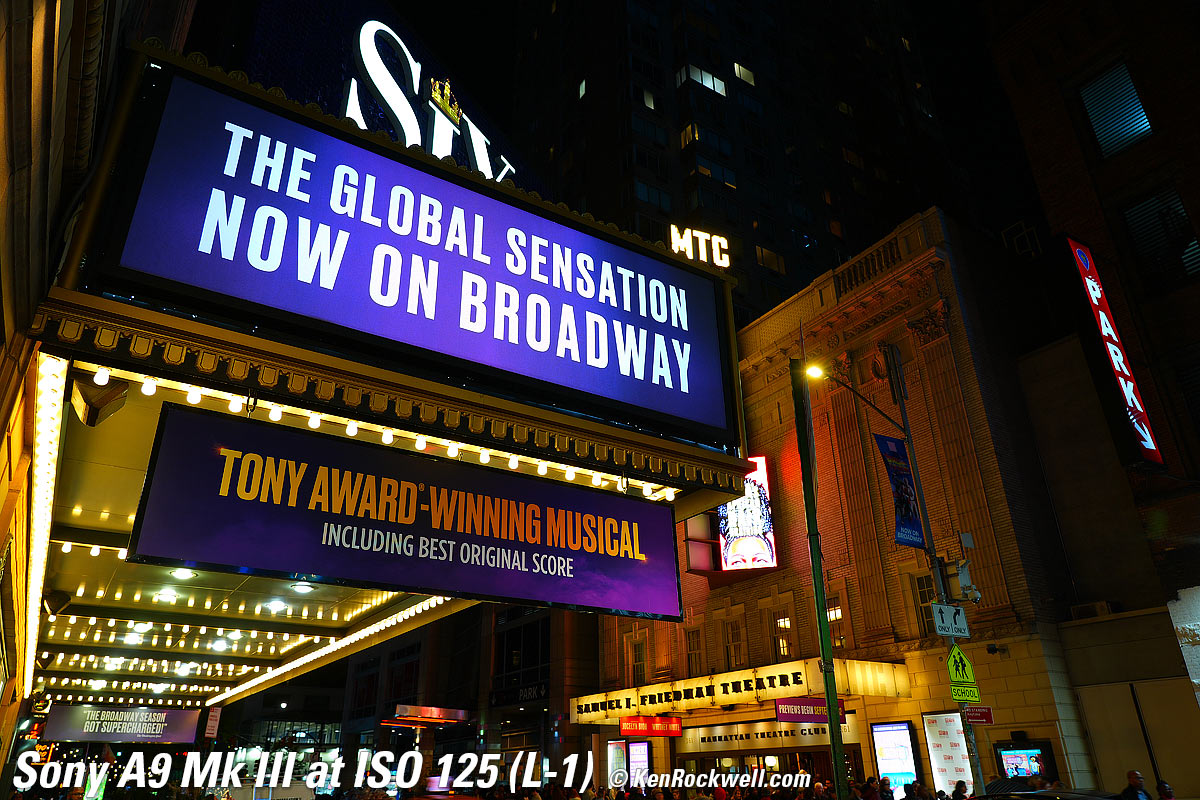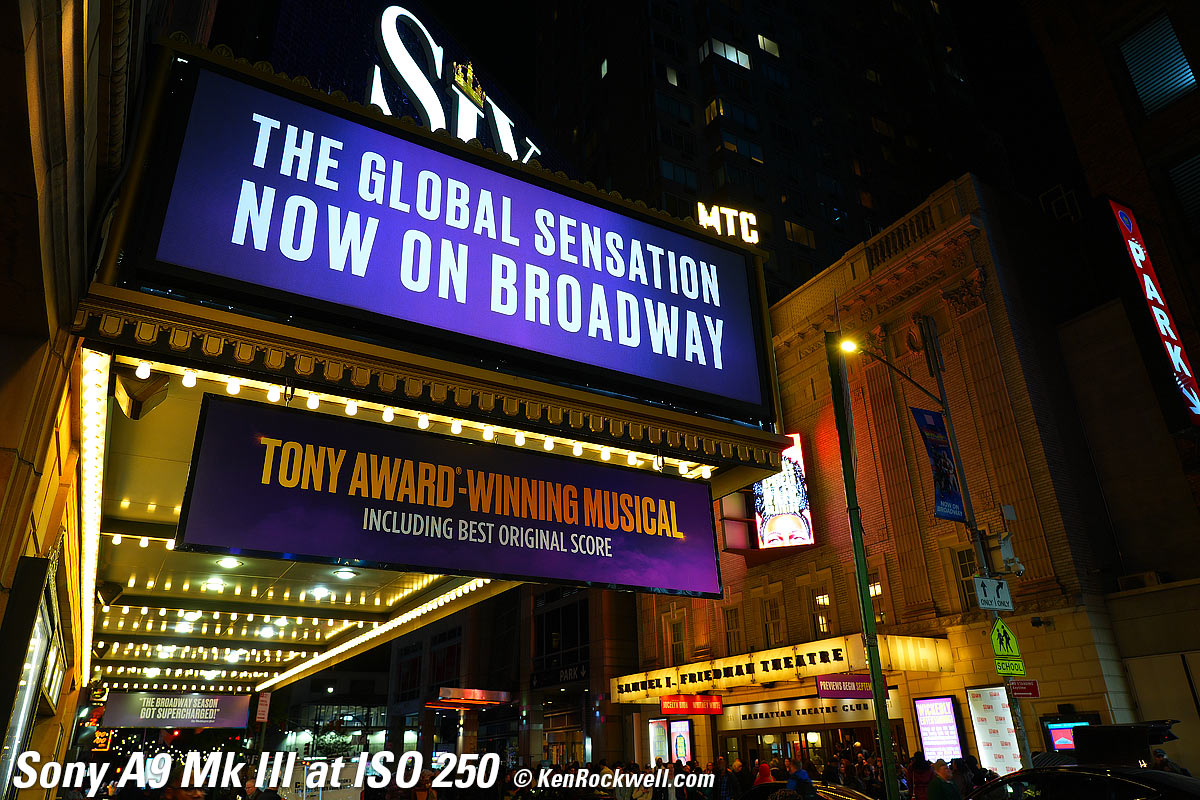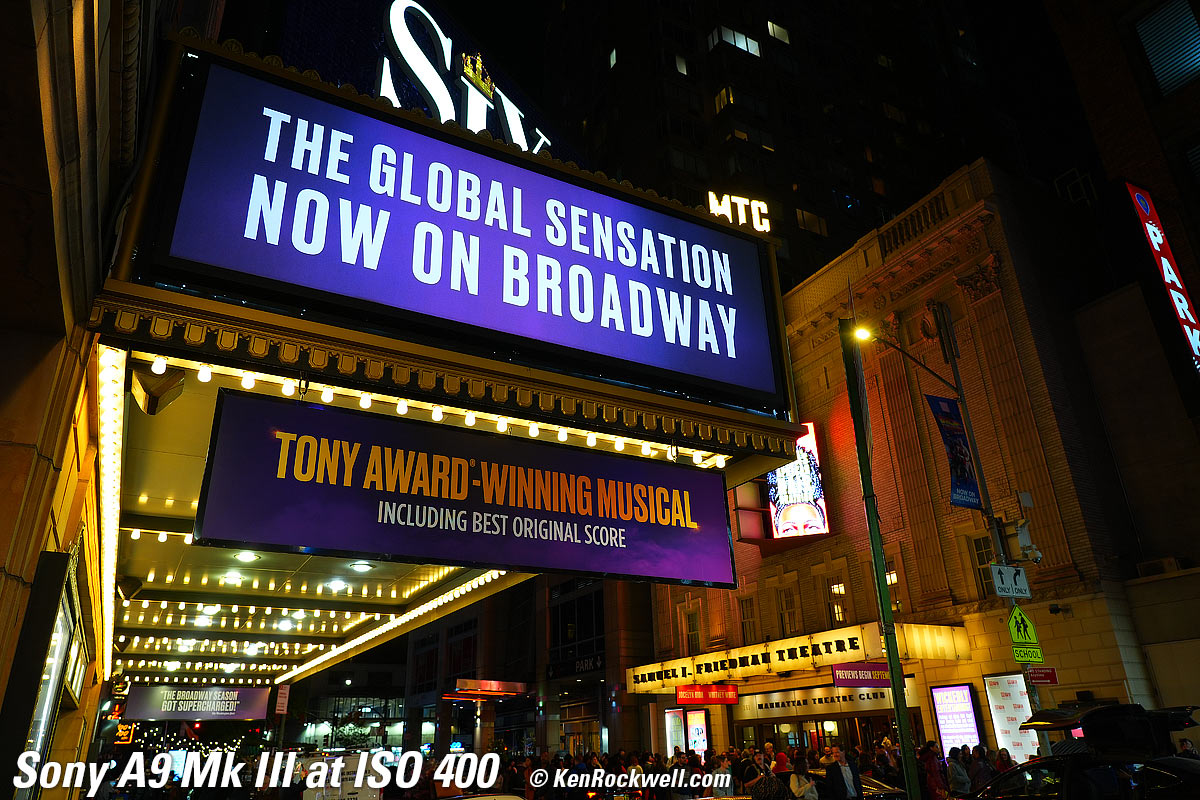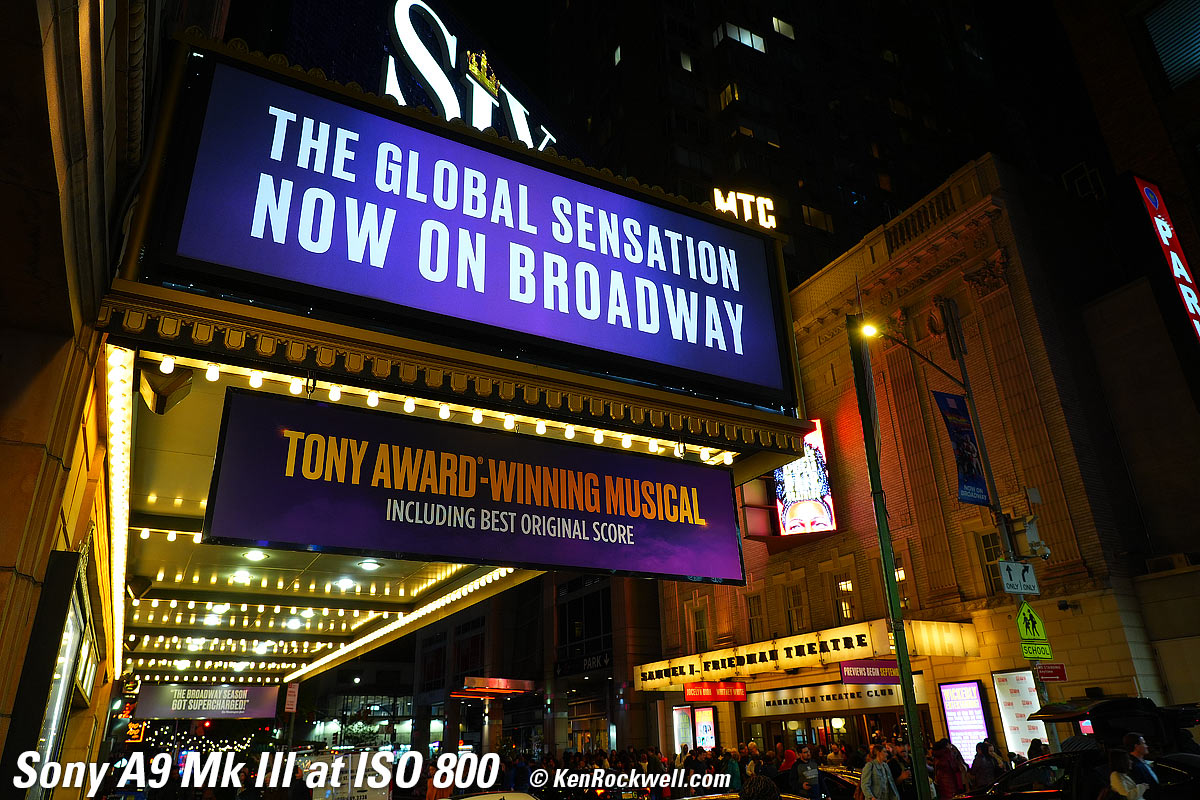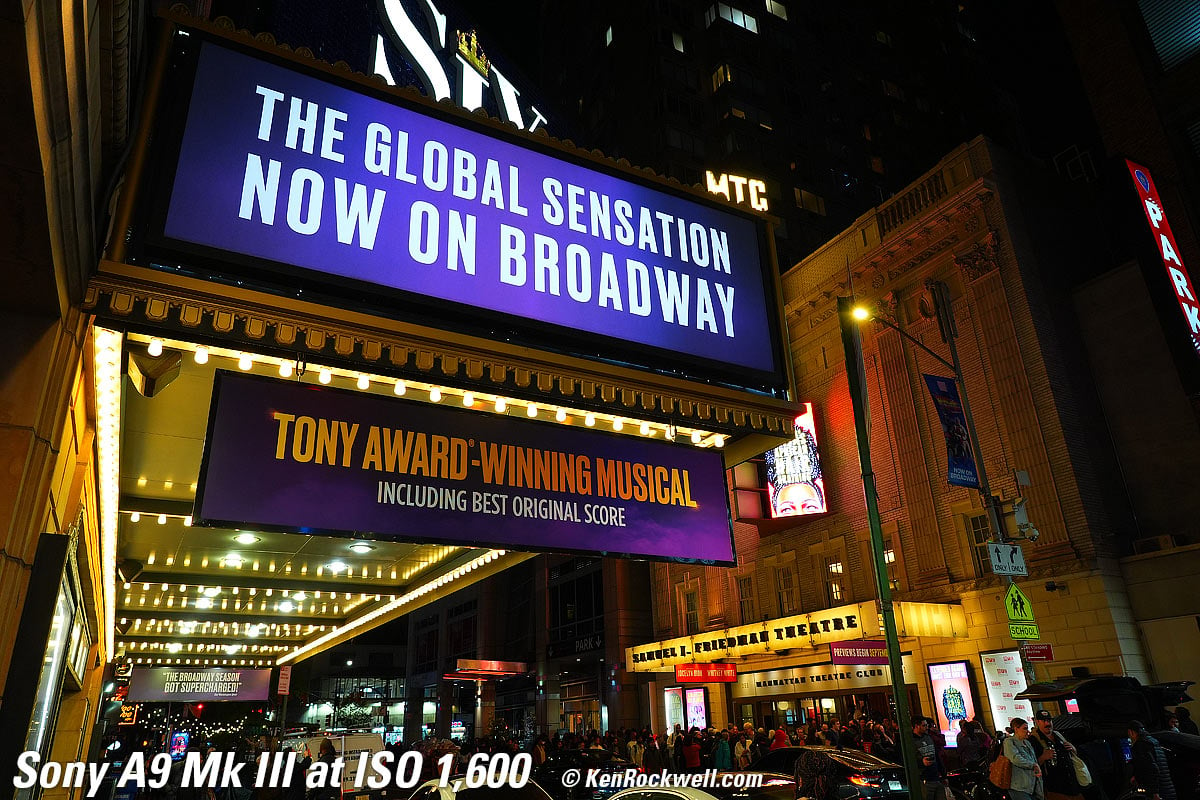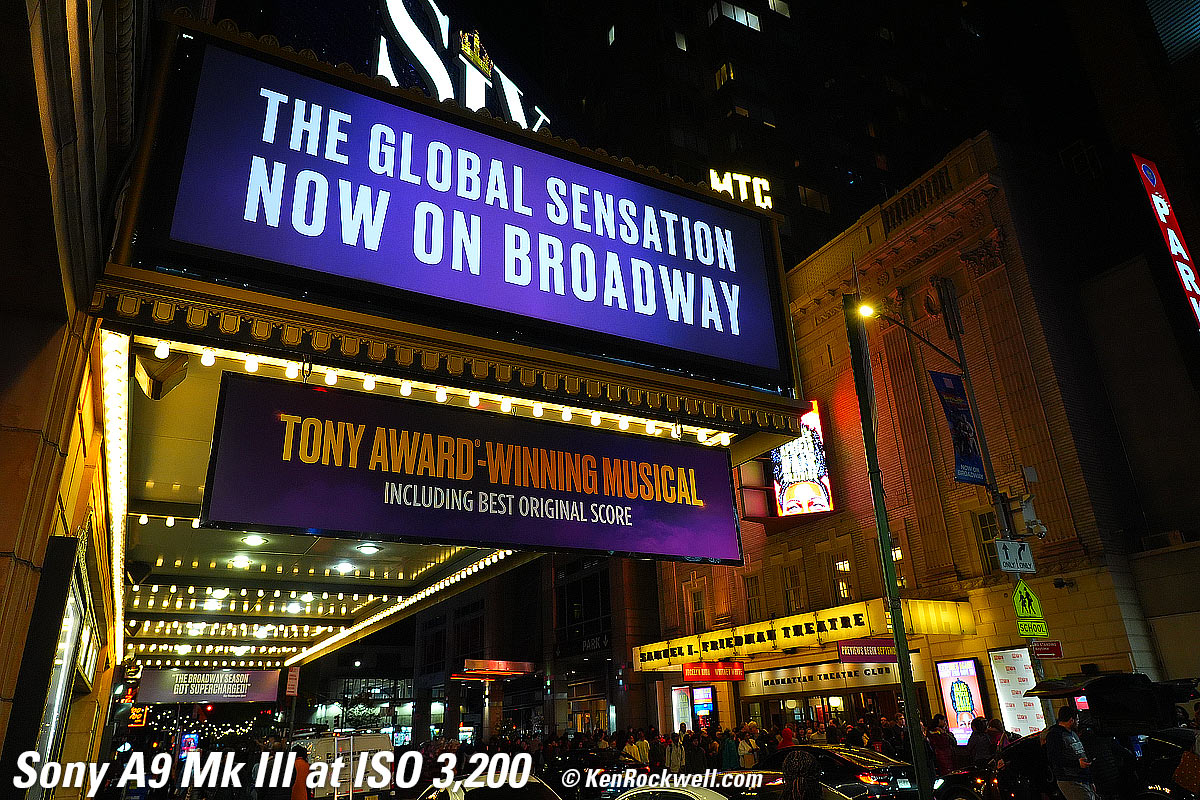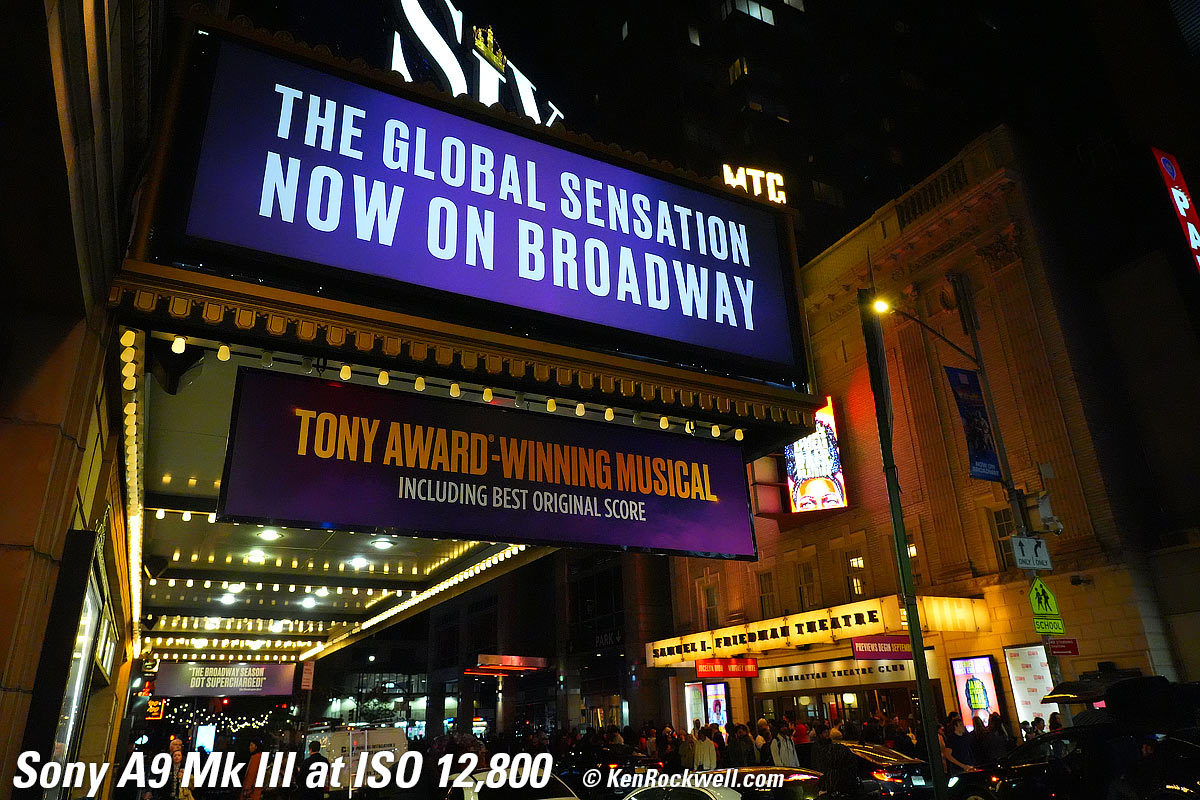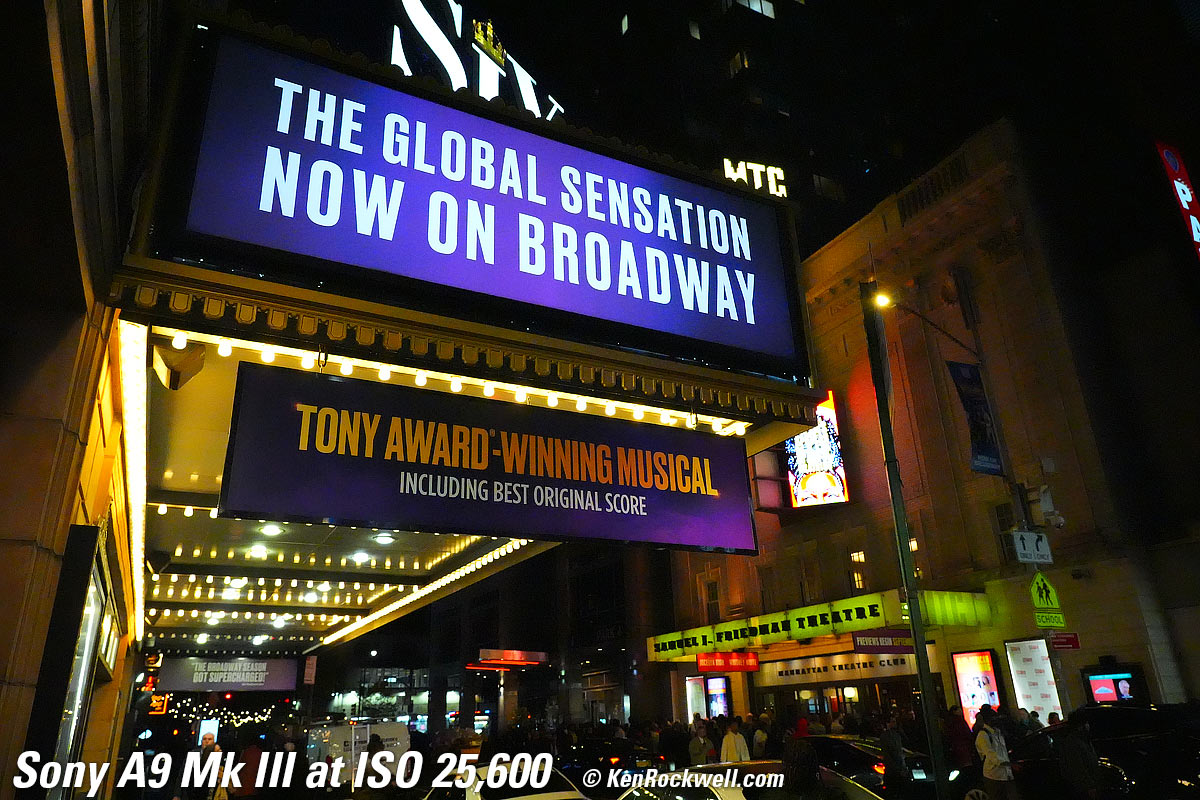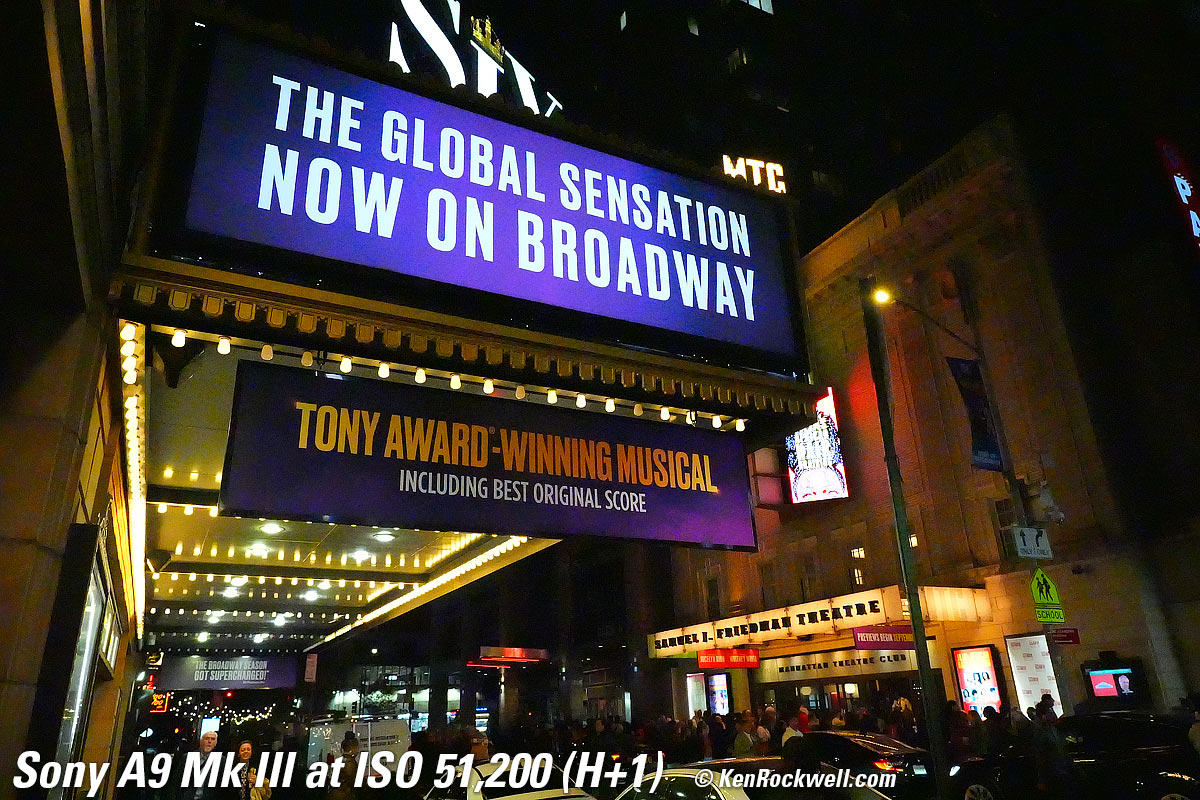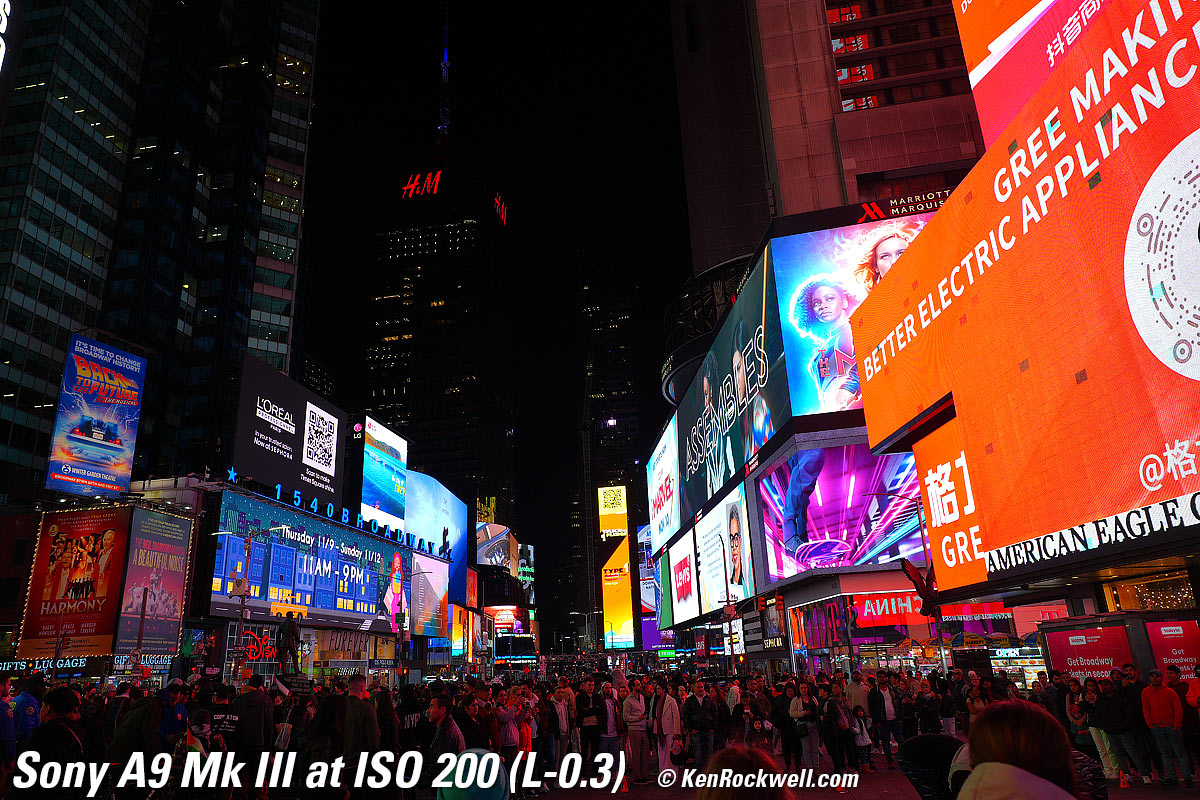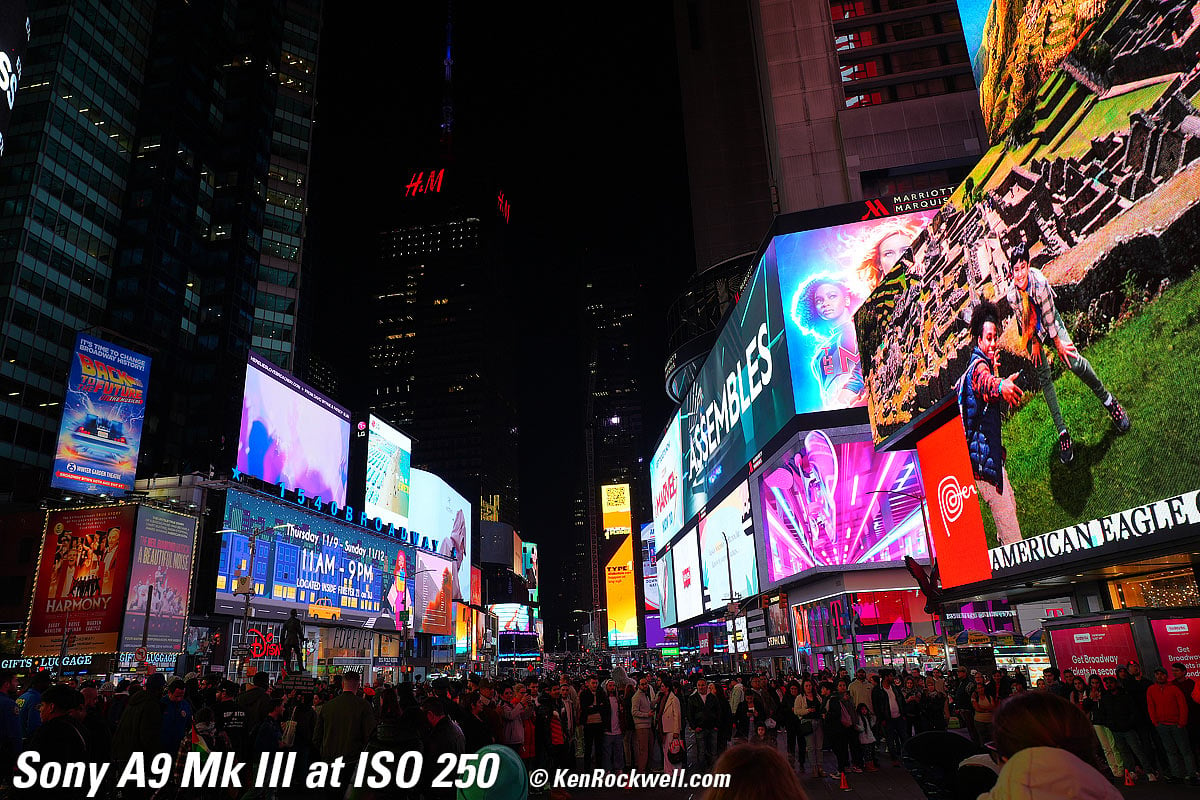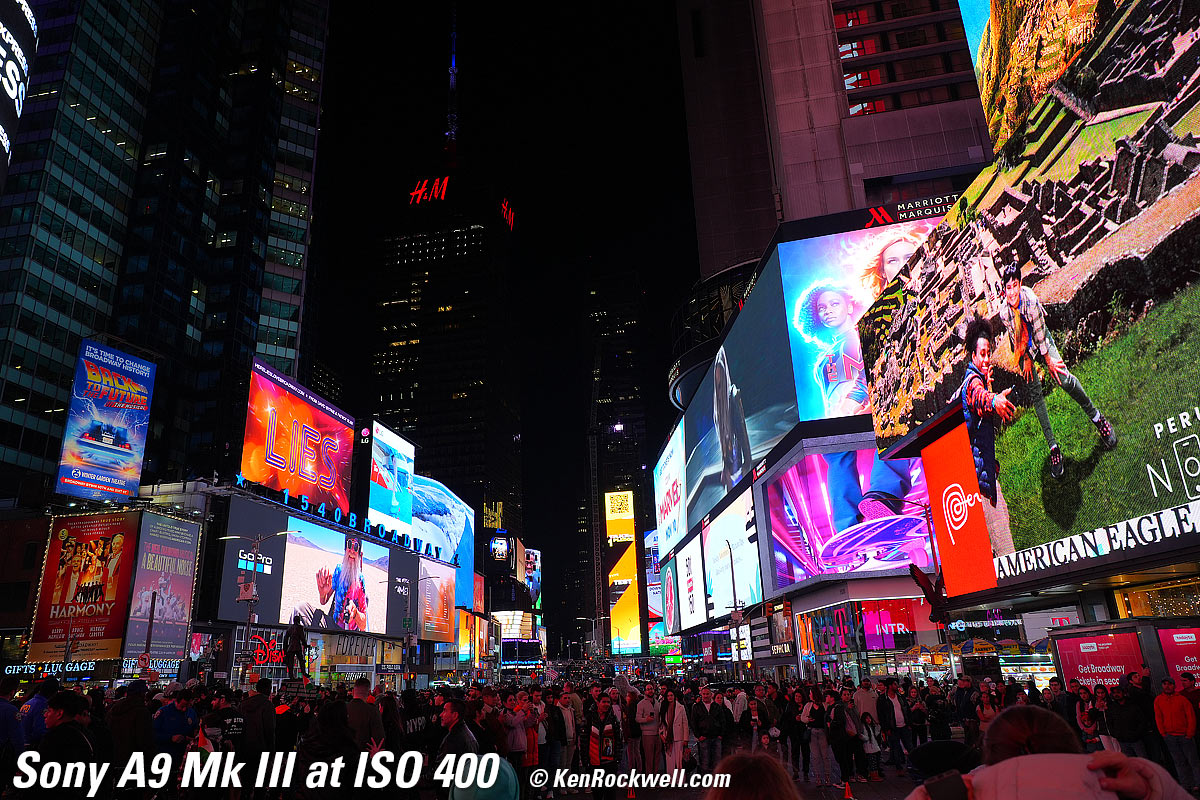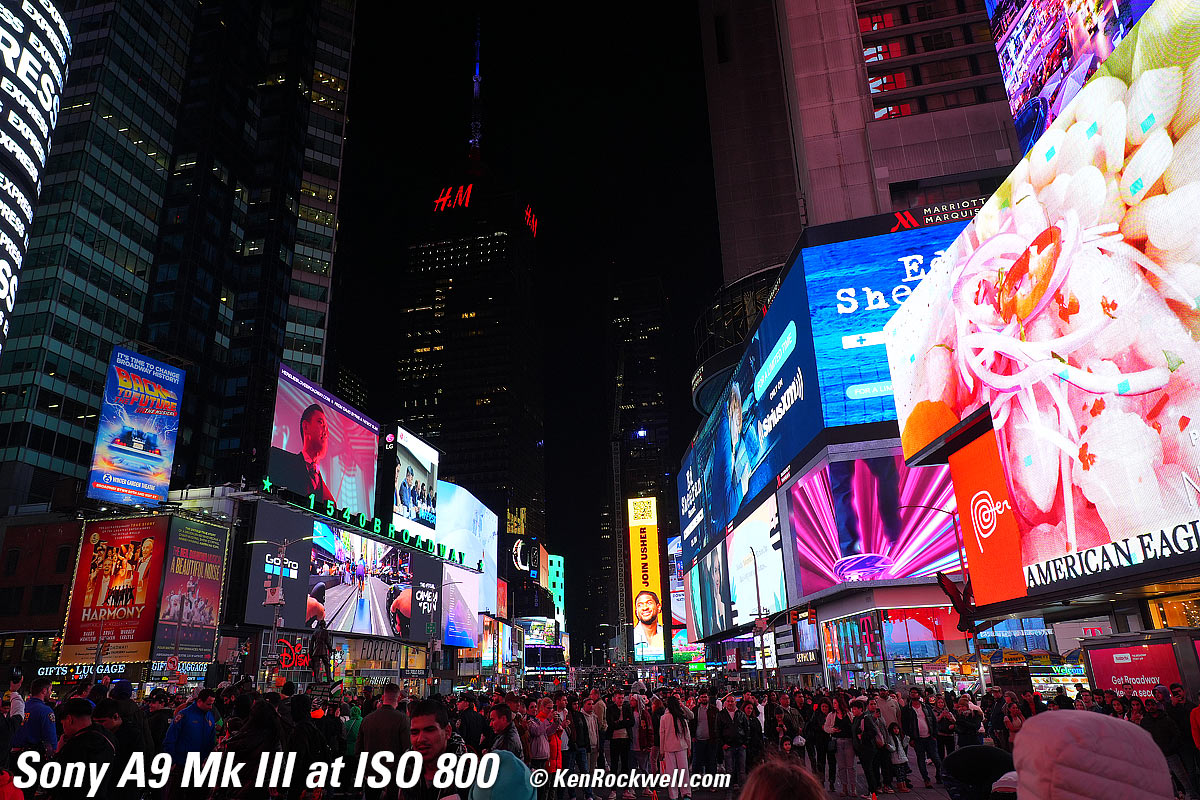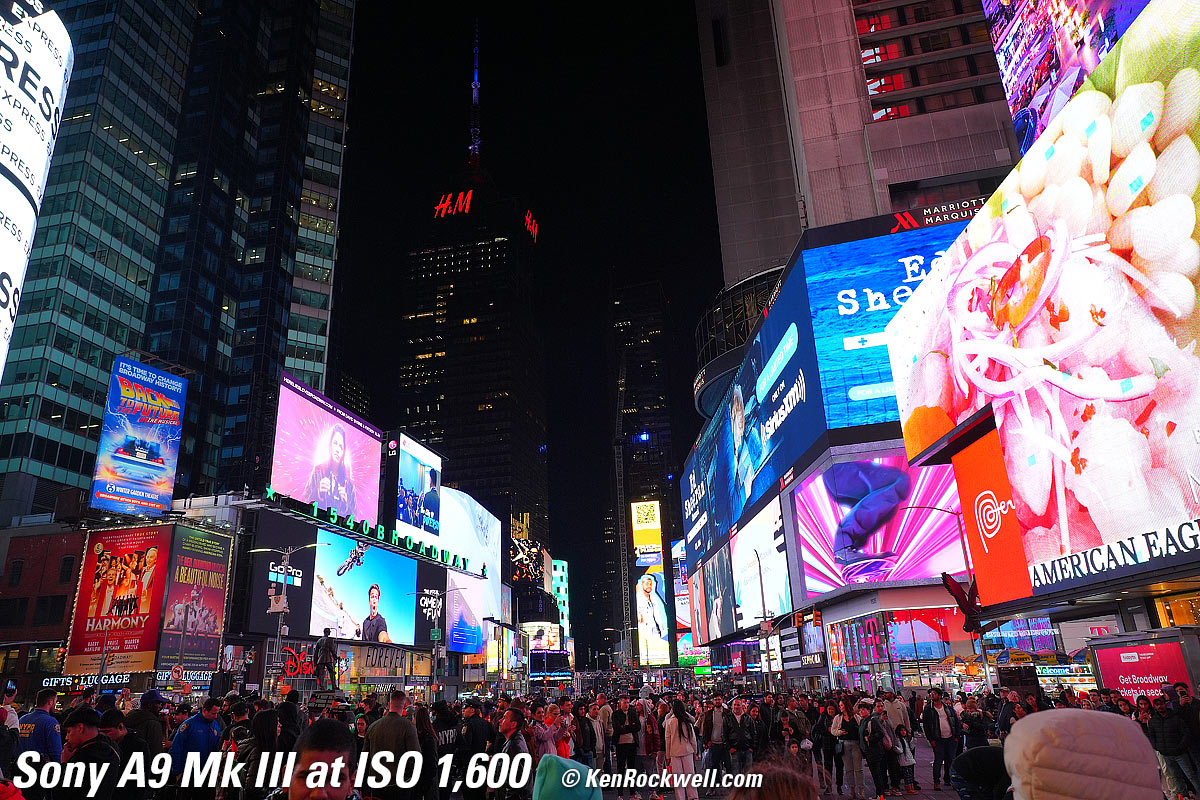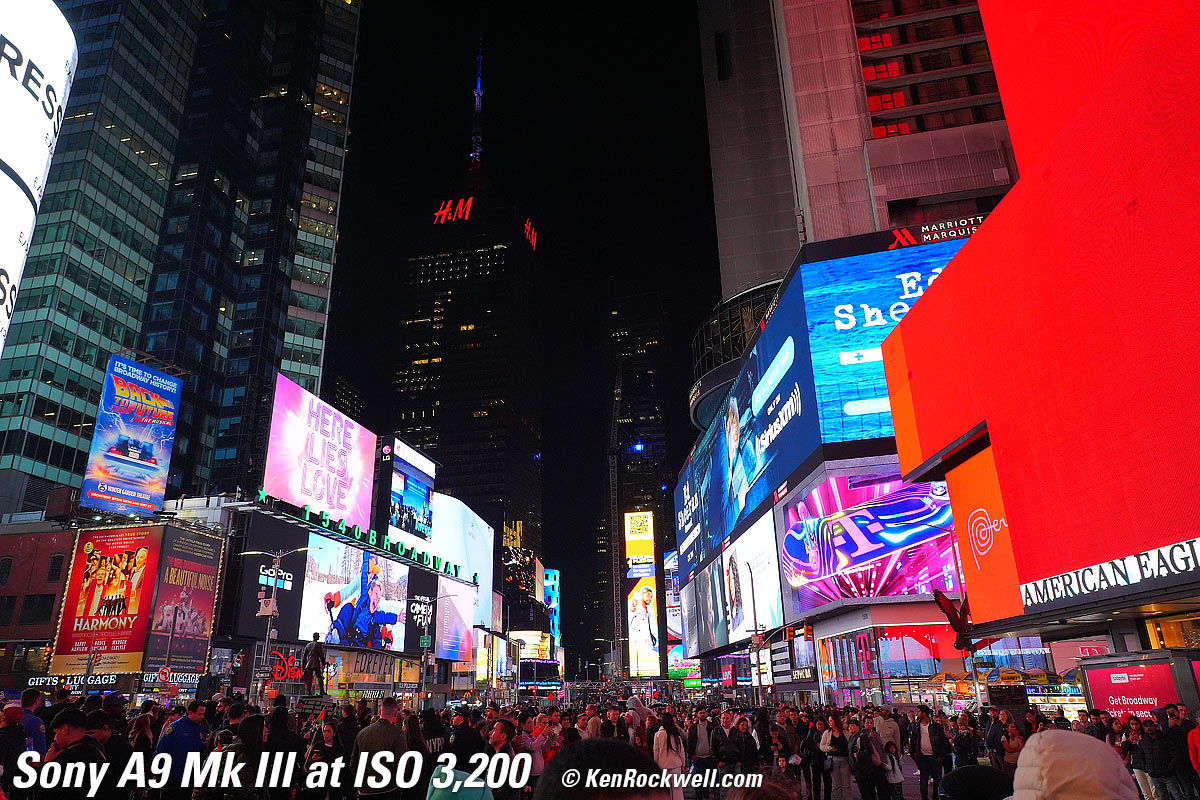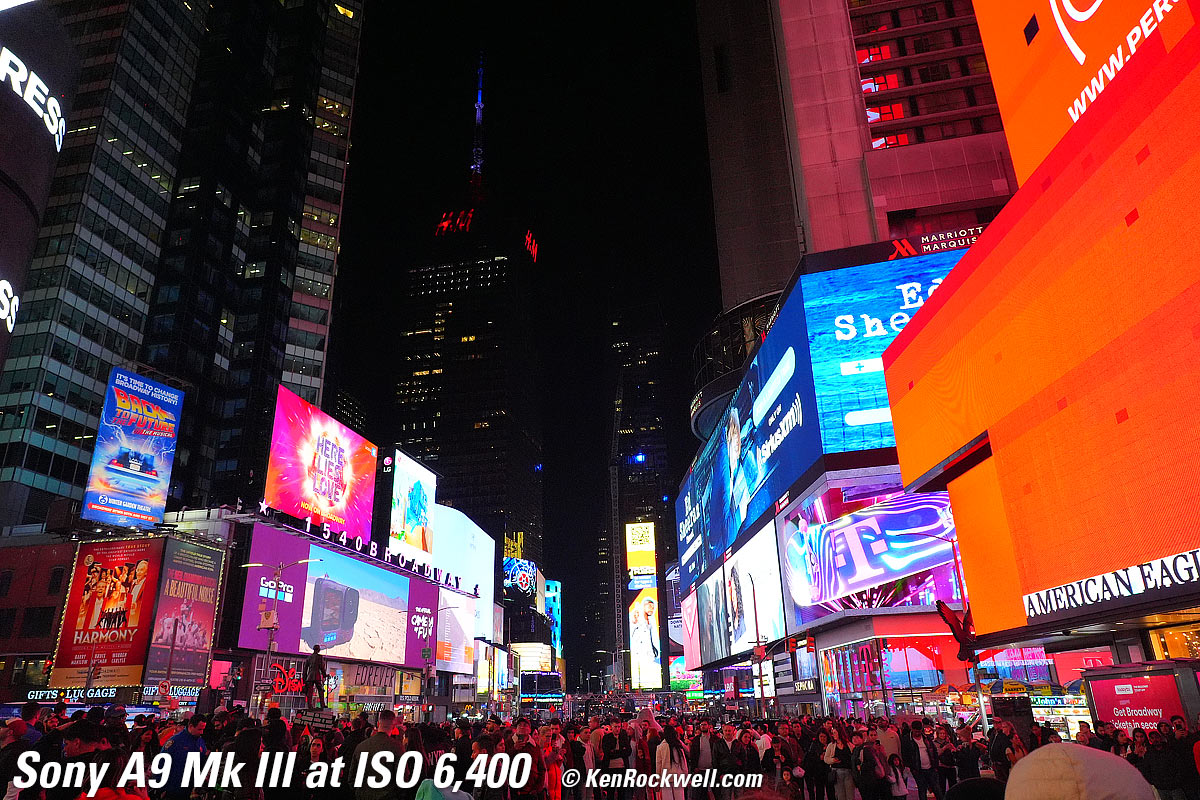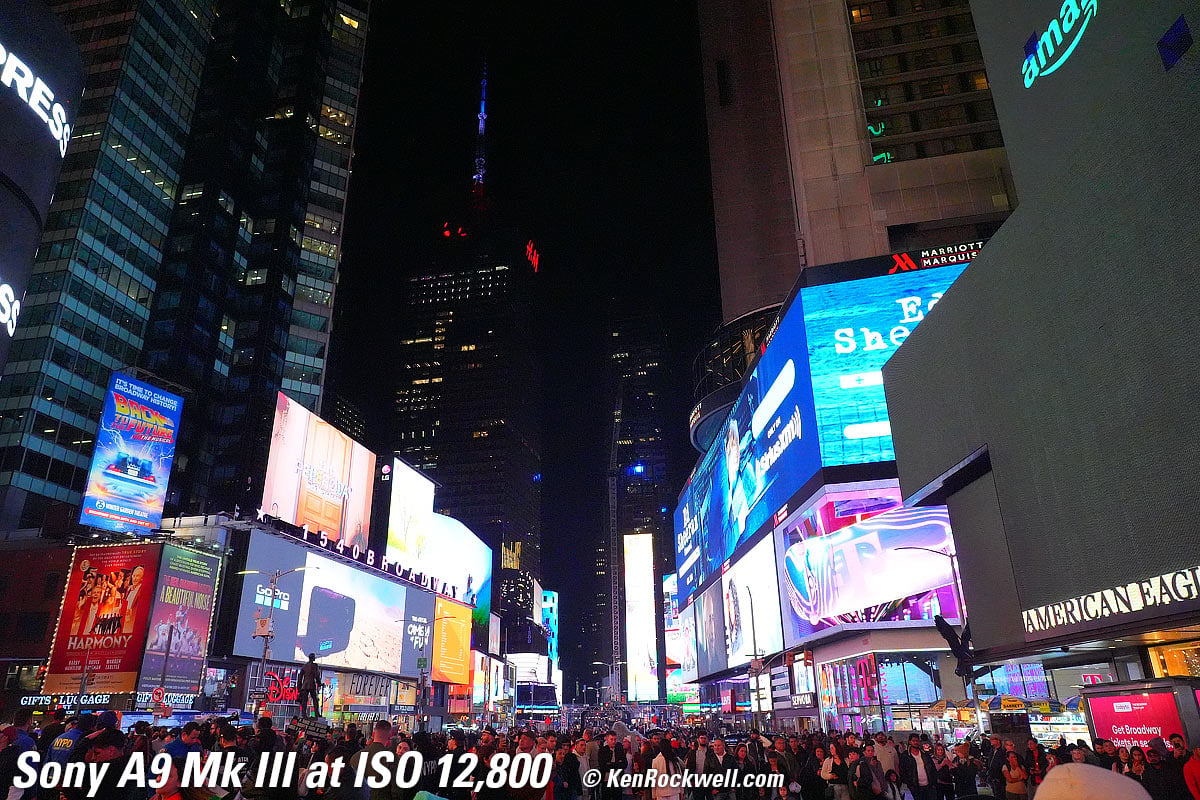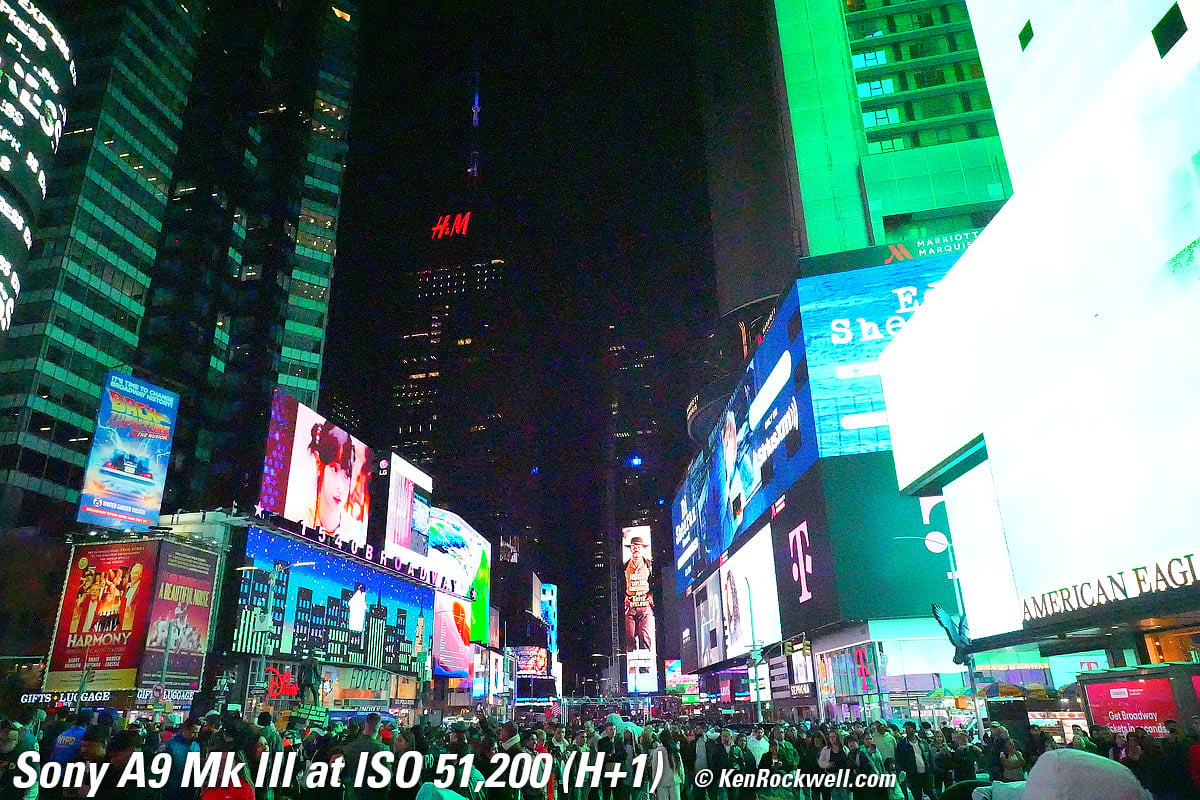Sony A9 III
Eye-Tracking 120 FPS, 24 MP Full-Frame IBIS, 1/80,000 Flash Sync, ISO 250~25,600 (125L~51,200H), 4K/120p
Sample Images Intro New Good Bad Missing
Sony: A9 III A1 A9 II A9 A7R V A7R IV A7R III A7 IV A7 III A7R II A7S III A7c A7 II A6600 A6400 A6100 A6000 ZV-E10 RX10/4 RX100/7 RX100/6 Flash Lenses
Sony A9 III (24.8 oz./703g with battery and a card, has two slots: each takes either an SD card or CFexpress type A card, $5,998) and Sony FE 20-70mm f/4 G. bigger. I'd get mine at Adorama, at Amazon, at B&H or at Crutchfield, or get it used at eBay if you know How to Win at eBay.
This 100% all-content, junk-free website's biggest source of support is when you use those or any of these links to my personally approved sources I've used myself for way over 100 combined years when you get anything, regardless of the country in which you live — but I receive nothing for my efforts if you take the chance of getting it elsewhere. Sony does not seal its boxes in any way, so never buy at retail or any other source not on my personally approved list since you'll have no way of knowing if you're missing accessories, getting a defective, damaged, returned, dropped, incomplete, gray-market, store demo or used camera — and my personally approved sources allow for 100% cash-back returns for at least 30 days if you don't love your new A9 III. I've used many of these sources since the 1970s because I can try it in my own hands and return it if I don't love it, and because they ship from secure remote warehouses where no one gets to touch your new camera before you do. Buy only from the approved sources I've used myself for decades for the best prices, service, return policies and selection.
March 2024, November 2023 Better Pictures Sony Sony Lenses Canon Nikon Fuji LEICA Zeiss All Reviews
Sony vs. Nikon vs. Canon Full-Frame
Canon, Nikon, Sony, Fuji & OM SYSTEM Menu Systems Compared
Sony A9 Mk III and Sony FE 300mm f/2.8 GM OSS. bigger.
Sample Images top
Sample Images Intro New Good Bad Missing
(more at High ISOs)
These are just snapshots; my real work is in my Gallery.
These are all shot hand-held as LIGHT JPGs (the smallest file type); no tripods, no FINE or EXTRA FINE JPGs or RAW files were used or needed.
Desert Hideaway, California, 4:42 PM, Friday, 23 February 2024. Sony A9 Mk III VIVID image with +9 Saturation, Sony FE 20-70mm f/4 G at 36mm at f/8 at 1/800 at Auto ISO 250 (LV 14⅓), Radiant Photo software. bigger or camera-original © file.
Desert Sunset, La Quinta, California, 5:38 PM, Friday, 23 February 2024. Sony A9 Mk III VIVID image with +9 Saturation, Sony FE 70-200mm f/4 G OSS MACRO II at 79mm at f/5 at 1/125 at Auto ISO 250 (LV 10.3), Radiant Photo and Skylum Luminar Neo software. bigger or camera-original © file.
Matador Red 1957 Chevrolet Bel Air, La Quinta Car Show, La Quinta, California, 10:43 AM, Saturday, 24 February 2024. Sony A9 Mk III VIVID image with +9 Saturation, Sony FE 20-70mm f/4 G at 70mm at f/8 at 1/1,250 at Auto ISO 250 (LV 15.0), Radiant Photo software. bigger or full-resolution 24 MP, 5 MB JPG file.
Basketball, Manhattan, 2:36 PM, Tuesday, 07 November 2023. Vertical crop from a horizontal Sony A9 Mk III image at +1 Saturation, Sony FE 70-200mm f/2.8 GM OSS II at 85mm at f/2.8 at 1/1,000 at Auto ISO 1,000, -0.7 stops exposure compensation (LV 9.6), exactly as shot. bigger or camera-original © file.
Chelsea Piers Fitness, Manhattan, 3:41 PM, Tuesday, 07 November 2023. Sony A9 Mk III at +1 Saturation, Sony FE 24-105mm f4 G OSS at 105mm at f/5.6 at 1/250 at Auto ISO 250 (LV 11.6), exactly as shot. bigger or camera-original © file.
Ironwork, Chelsea Piers, Manhattan, 3:54 PM, Tuesday, 07 November 2023. Sony A9 Mk III at +1 Saturation, Sony FE 24-105mm f4 G OSS at 105mm at f/8 at 1/200 at Auto ISO 250 (LV 12.3), color added in Photoshop CS6 since I forgot to amp-up the color in the Creative Controls in-camera. bigger or camera-original © file.
The Intrepid, Chelsea at Dusk, Pier 86, Manhattan, 4:43 PM, Tuesday, 07 November 2023. Sony A9 Mk III at +9 Saturation, Sony FE 24-105mm f4 G OSS at 24mm at f/11 at 1/15 at Auto ISO 250, -0.7 stops exposure compensation (LV 9.5), color and deliberate vignetting and contrast added in Photoshop CS6 (from 2012). bigger or camera-original © file.
Ho-Hum Pizzeria, 46th Street, Manhattan, 8:53 PM, Tuesday, 07 November 2023. Sony A9 Mk III shot through a window at +9 Saturation, Sony FE 24-105mm f4 G OSS at 24mm at f/4 at 1/40 at Auto ISO 250 (LV 8.0), Perfectly Clear (now sold as Radiant Photo). bigger.
Long Island's famous Villa Monte, run by a couple from Napoli (Naples), blows the place above out of the water. Tell them Rockwell sent you. Monte's puts out dozens and dozens of different pies from which you can order slices for lunch, with everything from regular pizza as you see above to Baked Ziti, Chicken Marsala or Veal Parmesan on a slice. Sorry, we fourth-generation native New Yorkers get personal about our favorite pizzerias (Monte photos with my iPhone 15 Pro Max).
11th Avenue Looking South from 46th Street, Manhattan, 9:03 PM, Tuesday, 07 November 2023. Sony A9 Mk III at +9 Saturation, Sony FE 24-105mm f4 G OSS at 24mm at f/4 at 1/15 hand-held at Auto ISO 1,000, -0.7 stops exposure compensation (LV 4.6), Perfectly Clear (now sold as Radiant Photo), perspective correction in Photoshop CS6 (from 2012) (I don't need no stinking perspective-control lenses). bigger or camera-original © file.
Introduction top
Sample Images Intro New Good Bad Missing
|
I buy only from these approved sources. I can't vouch for ads below. |
 The A9 III is unique in being the first full-frame camera that can read every pixel across the entire sensor at exactly the same instant, which means the end of the "rolling shutter" which leads to motion distortion and limits flash sync speeds in every other full-frame digital camera.
The A9 III is unique in being the first full-frame camera that can read every pixel across the entire sensor at exactly the same instant, which means the end of the "rolling shutter" which leads to motion distortion and limits flash sync speeds in every other full-frame digital camera.
 This new shutter allows a top speed of 1/80,000, with full flash sync at 1/80,000!
This new shutter allows a top speed of 1/80,000, with full flash sync at 1/80,000!
The rolling shutter was called a focal plane shutter with film, and it's brought the same limitations to almost every other interchangeable-lens camera for about the past 100 years.
 With the A9 III's new sensor technology we can shoot at up to 120 FPS with full eye-tracking autofocus and autoexposure tracking with no finder blackout and have flash sync at every shutter speed which now goes up to 1/80,000.
With the A9 III's new sensor technology we can shoot at up to 120 FPS with full eye-tracking autofocus and autoexposure tracking with no finder blackout and have flash sync at every shutter speed which now goes up to 1/80,000.
 Sony calls this technology a "Global Shutter," meaning every pixel is captured at exactly the same time. No longer do pixels need to be read out in order.
Sony calls this technology a "Global Shutter," meaning every pixel is captured at exactly the same time. No longer do pixels need to be read out in order.
 This new technology also means there is no banding in flickering light, and no half-exposed frames when someone else's flash fires at about the same time as yours. Now paparazzi either get the shot or don't; no longer will we get frames half-lit by other people's flash.
This new technology also means there is no banding in flickering light, and no half-exposed frames when someone else's flash fires at about the same time as yours. Now paparazzi either get the shot or don't; no longer will we get frames half-lit by other people's flash.
It can shoot 14 bit raw for 192 frames, which is about 6 GB of data in a 1.6 second burst! It captures each burst to an on-sensor DRAM buffer, which then can be read and recorded to your card when the burst is done.
 You can program a "boost" button to shoot at higher frame rates while shooting at lower ones. For instance, you can shoot at 20 FPS all day, and press a Cfn button to make it jump to, say 120 FPS. Sadly you can't change the frame rate by simply pressing the shutter button harder; you still have to use a second button to shift speeds. My U.S. Patent 11,539,886 covers using just the shutter button and we all hope Sony adds this.
You can program a "boost" button to shoot at higher frame rates while shooting at lower ones. For instance, you can shoot at 20 FPS all day, and press a Cfn button to make it jump to, say 120 FPS. Sadly you can't change the frame rate by simply pressing the shutter button harder; you still have to use a second button to shift speeds. My U.S. Patent 11,539,886 covers using just the shutter button and we all hope Sony adds this.
 Precapture can capture everything up to a second before you press the shutter!
Precapture can capture everything up to a second before you press the shutter!
In exchange for these significant benefits the sensor has a limited ISO range of only ISO 250 ~ 25,600 (125L ~ 51,200H). This is fine, as the A9 III is intended for big-league, full time pros who light their sets and arenas properly; this isn't a camera for shooters who need foolishly high ISOs settings that look crappy anyway. The A9 III looks as good at ISO 51,200 as other cameras that go higher; it's just that the A9 III only goes to 51,200 probably because its processors can't do more noise reduction at 120 FPS. Big time shooters rarely need anything above ISO 6,400; we light our sets well. If you're still counting pixels or ISOs then stick with the Sony A1.
My A9 III seemed to run through batteries pretty fast, but that also could be because I was playing with it so much.
Only if you order yours today, Sony says it should ship in Spring 2024, and if all goes well and you have yours on order it might ship as soon as 08 February, 2024.
I'd order my A9 III at Adorama, at Amazon or at B&H, or eventually get it used at eBay if you know How to Win at eBay.
New intro top
 120 FPS with full eye focus and exposure tracking.
120 FPS with full eye focus and exposure tracking.
 Crazy new LCD flippy mechanism. It's as complex as Nikon's, and far better than Nikon, actually lets us flip the screen any way we like:
Crazy new LCD flippy mechanism. It's as complex as Nikon's, and far better than Nikon, actually lets us flip the screen any way we like:
Sony A9 Mk III and Sony FE 24-105mm f4 G OSS. bigger.
 Five selectable AF point sizes, now including extra big and extra small.
Five selectable AF point sizes, now including extra big and extra small.
 8-stop IBIS.
8-stop IBIS.
 1/80,000 top shutter speed.
1/80,000 top shutter speed.
 Flash sync at all speeds including 1/80,000.
Flash sync at all speeds including 1/80,000.
Good intro top
 Fast!!!
Fast!!!
 1/80,000 flash sync!!!
1/80,000 flash sync!!!
 Each slot takes any kind of SD card (UHS-I/II) or an exotic CFexpress type A card, your choice. Bravo!
Each slot takes any kind of SD card (UHS-I/II) or an exotic CFexpress type A card, your choice. Bravo!
 File names seem to have five figures (DSC#####.jpg) instead of just four (DSC_####.jpg), so we may be able to shoot 100,000 frames and put them in the same folder before our computer's file system breaks with duplicate file names. At 120 FPS it's very easy to shoot 10,000 frames at any event which makes it very difficult to sort images or put them in the same folder. With only 10,000 unique file names, images can start duplicating file names after just 83 seconds of continuous shooting at 120 FPS! Ideally we should have the option to use more digits and fewer fixed letters instead of being locked-into just five digits, oddly LEICA and their slow cameras are the only ones who get this right with seven digits (L#######.jpg) offering ten million shots before it rolls over. I haven't confirmed if the A9 III really can count up to DSC99999.jpg, or if that zero is just window dressing.
File names seem to have five figures (DSC#####.jpg) instead of just four (DSC_####.jpg), so we may be able to shoot 100,000 frames and put them in the same folder before our computer's file system breaks with duplicate file names. At 120 FPS it's very easy to shoot 10,000 frames at any event which makes it very difficult to sort images or put them in the same folder. With only 10,000 unique file names, images can start duplicating file names after just 83 seconds of continuous shooting at 120 FPS! Ideally we should have the option to use more digits and fewer fixed letters instead of being locked-into just five digits, oddly LEICA and their slow cameras are the only ones who get this right with seven digits (L#######.jpg) offering ten million shots before it rolls over. I haven't confirmed if the A9 III really can count up to DSC99999.jpg, or if that zero is just window dressing.
 Big, sharp finder with no blackout.
Big, sharp finder with no blackout.
 Sensor-shift Image Stabilization.
Sensor-shift Image Stabilization.
Bad intro top
 While the AF system has impressive marketing claims, it's also so incredibly complex that I never really figured it out. If I, who has over 55 years of extensive experience shooting essentially every camera ever made is honest enough to admit that I can't get good results from this AF system, I doubt that anyone other than a full-time pro who shoots nothing but this A9 III every single day will ever be able to get consistent results from this AF system. I suspect it can work well, but if you or I can't figure out all the options, what good is it?
While the AF system has impressive marketing claims, it's also so incredibly complex that I never really figured it out. If I, who has over 55 years of extensive experience shooting essentially every camera ever made is honest enough to admit that I can't get good results from this AF system, I doubt that anyone other than a full-time pro who shoots nothing but this A9 III every single day will ever be able to get consistent results from this AF system. I suspect it can work well, but if you or I can't figure out all the options, what good is it?
 The AF system has no automatic subject recognition (the Canon EOS R6 II for instance has Auto Subject Detection). Instead, you manually have to tell the A9 III at MENU > AF/MF > 3. Subject Recognition > Recognition target for what kind of subject (Human, Animals/bird, Animal, Bird, Insect, Car/train or Airplane) you want it to find. If I have to set this manually, is it really autofocus?
The AF system has no automatic subject recognition (the Canon EOS R6 II for instance has Auto Subject Detection). Instead, you manually have to tell the A9 III at MENU > AF/MF > 3. Subject Recognition > Recognition target for what kind of subject (Human, Animals/bird, Animal, Bird, Insect, Car/train or Airplane) you want it to find. If I have to set this manually, is it really autofocus?
 The default finder AUTO brightness control doesn't go bright enough outdoors, so it's too dim. I have to set +2 brightness manually, which I shouldn't have to do. If I don't set this manually, the finder is dim outdoors. Boo!
The default finder AUTO brightness control doesn't go bright enough outdoors, so it's too dim. I have to set +2 brightness manually, which I shouldn't have to do. If I don't set this manually, the finder is dim outdoors. Boo!
 Limited ISO range and performance. It covers all the ISOs you'd need and does it well, but if you are more interested in six-digit ISOs, this isn't the camera. If you need six-digit ISOs you're doing something wrong, so I don't worry about this.
Limited ISO range and performance. It covers all the ISOs you'd need and does it well, but if you are more interested in six-digit ISOs, this isn't the camera. If you need six-digit ISOs you're doing something wrong, so I don't worry about this.
 Limited buffer depth: 192 frames.
Limited buffer depth: 192 frames.
 Production dumped to Thailand, not made domestically in Japan.
Production dumped to Thailand, not made domestically in Japan.
 The card door has a double interlock that takes longer to open. You have to slide a latch to the side before you can pull the door rearward. I prefer unlatched card doors where any rearward pull slides them open. I've never had any problem with simpler doors popping open, and it does take longer to open the A9 III door. Laugh all you want, but the A9 III is all about speed, and door locks get in my way.
The card door has a double interlock that takes longer to open. You have to slide a latch to the side before you can pull the door rearward. I prefer unlatched card doors where any rearward pull slides them open. I've never had any problem with simpler doors popping open, and it does take longer to open the A9 III door. Laugh all you want, but the A9 III is all about speed, and door locks get in my way.
Missing intro top
 Can't program frame rate to vary with how hard you press the shutter button. Instead, you can program a "boost" button to shoot at higher frame rates while you press another button. My U.S. Patent 11,539,886 covers using just the shutter button; we all hope Sony adds this.
Can't program frame rate to vary with how hard you press the shutter button. Instead, you can program a "boost" button to shoot at higher frame rates while you press another button. My U.S. Patent 11,539,886 covers using just the shutter button; we all hope Sony adds this.
 No automatic brightness control for rear LCD.
No automatic brightness control for rear LCD.
 No timed manual exposures longer than 30 seconds. You have to use Bulb, a remote release and an external timer instead. Even the first Nikon F5 of 1996 gave manual exposures out to 30 minutes.
No timed manual exposures longer than 30 seconds. You have to use Bulb, a remote release and an external timer instead. Even the first Nikon F5 of 1996 gave manual exposures out to 30 minutes.
 Like most cameras, no illuminated buttons.
Like most cameras, no illuminated buttons.
 Like most cameras, advance mode icons are simply labeled as L, H and H+ instead of their actual frame rates (3 FPS, 10 FPS, 120 FPS, etc.).
Like most cameras, advance mode icons are simply labeled as L, H and H+ instead of their actual frame rates (3 FPS, 10 FPS, 120 FPS, etc.).
 Not threaded to use a standard threaded cable release.
Not threaded to use a standard threaded cable release.
 No GPS.
No GPS.
 No "Delete Burst" option during playback - unless you have playback set only to show the first frame of each burst, in which case you will delete the entire burst.
No "Delete Burst" option during playback - unless you have playback set only to show the first frame of each burst, in which case you will delete the entire burst.
 No shutter speed dial.
No shutter speed dial.
 No ISO dial.
No ISO dial.
 No really high or low ISOs.
No really high or low ISOs.
 No color histograms while shooting (only on playback).
No color histograms while shooting (only on playback).
Specifications top
Sample Images Intro New Good Bad Missing
I'd order my A9 III at Adorama, at Amazon or at B&H, or eventually get it used at eBay if you know How to Win at eBay.
Sensor specifications top
24 MP.
23.8 × 35.6 mm CMOS.
3:2 aspect ratio.
1.01 × crop factor.
ISO specifications top
ISO 250 ~ 25,600.
Pulls to ISO 200, ISO 160 or ISO 125.
Pushes to ISO 32,000, ISO 40,000 or ISO 51,200.
White Balance specifications top
The usual, along with a manual 2,500 K ~ 9,900 K Kelvin range.
Image Sizes specifications top
6,000 × 4,000 pixels native (24,000,000 pixels).
3,936 × 2,632 Medium (10 MP).
3,008 × 2,000 Small (6 MP).
Stabilization specifications top
Moving Sensor.
Rated "8 stops improvement."
Lens Corrections specifications top
Falloff ("peripheral illumination").
Distortion.
Lateral color.
Breathing (for video).
Still Formats specifications top
JPG, HEIF and/or ARW 5.0 raw.
sRGB and Adobe RGB.
Video specifications top
File Formats
XAVC S: MPEG-4 AVC/H.264.
XAVC HS: MPEG-H HEVC/H.265.
Frame Sizes and Rates
4K at 119.88, 59.94, 29.97 or 23.976 FPS (there's got to be 100/50/25 in there someplace).
1,920 × 1,080 at 59.94, 29.97 or 23.976 FPS (there's got to be 50 and 25 in there someplace).
Also time lapse and slo-mo.
Audio specifications top
LPCM at 48 ksps at 16- or 24-bits.
S - t - e - r - e - O microphone built in.
3.5mm mic-in jack with plug-in power overrides built-in mic.
3.5mm headphone jack.
Single mono speaker.
Autofocus specifications top
759 AF points cover 96% area,
LV -5 to +20 with an f/2 lens.
White LED AF Assist light.
Light Meter specifications top
1,200 zone.
LV -3 ~ +20 with an f/2 lens.
Finder specifications top
0.64" (1.6 cm) OLED.
9,437,184 dots.
0.90× magnification with 50mm lens.
41º apparent field of view.
Auto brightness control.
-4 ~ +3 diopters.
21 mm eyepoint (25mm from the glass lens deeper inside the eyepiece).
60 FPS standard, 120 FPS Hi and 240 FPS Hi+.
Shutter specifications top
Mechanical Shutter
None, and none needed.
Silent Electronic Shutter
1/80,000 ~ 30 seconds in single-frame mode.
"Only" goes to 1/16,000 in continuous shooting and "only" to 1/8,000 in video.
Hint: Video looks best with shutter speeds of twice the frame rate (a 180º shutter in film parlance, or 1/50 at 25 FPS for instance). Shorter video shutter speeds make the motion jerky or "strobed," which is best used as a special effect to create tension. Use an ND filter to let you use the correct speeds for most video storytelling outdoors; these cameras tend to have to default to speeds much too fast for rendering motion naturally.
Bulb.
Flash sync at all speeds, including 1/80,000. Sony's specs imply that it might limit you to 1/500 with non-Sony brand flash; I haven't tried it otherwise.
I do know mine works flawlessly at 1/1,000 with the Sony HVL-F60R Mk II flash.
Remote Releases specifications top
Use the free app to control it over Bluetooth.
Buffer (Burst) Sizes specifications top
192 frames.
Flash specifications top
1/80,000 sync speed.
Built-in Flash
None.
External Flash
Dedicated hot shoe.
Standard PC (Prontor-Compur) flash sync terminal.
LCD Monitor specifications top
3.2" (80 mm) diagonal, 2,095,104 dot touch-screen LCD on an unusually flippy mechanism.
It rotates 98º up and 40º down.
It flips out 180º horizontally:
Sony A9 Mk III and Sony FE 24-105mm f4 G OSS. bigger.
When flipped out as shown, flips around 270º.
It can do all sorts of crazy things like this below, and even flips forwards.
Sony A9 Mk III and Sony FE 16-35mm f/2.8 GM II. bigger.
Connectors specifications top
Sony A9 Mk III connectors. bigger.
Left Column, from top
Gigabit Ethernet.
HDMI Full Size Type A: 4K at 59.94p, 29.97p and 23.976p, 1,920 x 1,080 at 59.94p, 59.94i and 23.976p, YCbCr 4:2:2 10bit, RGB 8bi , 4,672 x 2,628 at 59.94p, 29.97p and 23.976p or Raw 16bit.
PC (Prontor-Compur) flash sync terminal.
Right Column, from top
3.5mm mic input.
3.5mm headphone jack.
USB-C 3.2 (10 Gbps) for video live streaming, data and charging. Streams MJPEG YUV 4:2:0 4K at 15p or 30p; 1,920 x 1,080 at 30 or 60p and 1,280 x 720 at 30p with LPCM 48 ksps 16 bit audio.
Micro USB "multi interface."
Speaker (behind two holes).
Wi-Fi specifications top
IEEE 802.11a/b/g/n/ac.
2.4 GHz and 5 GHz.
NFC specifications top
No.
Bluetooth specifications top
v 5.0.
2.4 GHz.
GPS specifications top
No, use the app.
Storage specifications top
Two slots. Each takes either an SD card (UHS-I/II) or a CFexpress type A card:
Sony A9 Mk III Card Door. bigger.
Quality specifications top
Bottom, Sony A9 Mk III and Sony FE 16-35mm f/2.8 GM II. bigger.
Made in Thailand.
Power & Battery specifications top
Battery
Rated 410 still shots or 90 minutes of video shooting with the viewfinder.
Rated 520 still shots or 95 minutes of video shooting with the rear LCD.
Power consumption is rated 4.8 W for still shooting or 6.8 W for video with the finder (3.8W or 6.6W with the LCD).
NP-FZ100 rechargeable lithium ion battery:
Sony NP-FZ100 battery. enlarge.
Sony NP-FZ100 battery. enlarge.
It's 7.2V, 2,280 mAh, 16.4 Wh.
Charging
It charges via USB in-camera, or also charges in the included BC-QZ1 Corded Battery Charger.
Although I prefer a folding plug charger, the included universal corded charger works anywhere with the right cord.
A nice feature is the three-segment battery status indicator. It shows about 2/3 charged here:
Sony BC-QZ1 Battery Charger with NP-FZ100 battery. bigger.
Sony BC-QZ1 Battery Charger. bigger.
The BC-QZ1 is rated 100~240V, 50/60 Hz, 0.38A in, and 8.4VDC @ 1.6A out.
You can charge two batteries at once; one in the camera via USB and the other in this charger.
Size specifications top
Depth overall from grip to eyepiece
3.81 × 5.36 × 3.26 inches HWD,.
96.9 × 136.1 × 82.9 millimeters HWD.
Depth only from grip to monitor
3.81 × 5.36 × 2.87 inches HWD.
96.9 × 136.1 × 72.8 millimeters HWD.
Weight specifications top
24.8 oz. (703 g) with battery and a card.
21.8 oz. (618 g) stripped.
Environment specifications top
Operating
0º ~ 40º C (32º ~ 104º F).
Sony's Model Number specifications top
ILCE-9M3.
Included specifications top
A9 III body with attached eyecup.
Hot shoe cover.
Shoulder strap.
NP-FZ100 battery.
BC-QZ1 Charger and AC power cord.
Cable protector.
Announced specifications top
9:30 AM, Tuesday, 07 November 2023, in Manhattan.
Promised for specifications top
As of 06 February 2024, Sony claims it may start shipping on 08 February 2024.
This is good; back in November 2023 Sony was expecting that if all went well and you had yours on order it might ship as soon as 21 February, 2024.
Available specifications top
08 February 2024.
Price, U. S. A. specifications top
03 March 2024
$5,998 at Adorama, at Amazon, at B&H and at Crutchfield.
About $5,600 used if you know How to Win at eBay.
November 2023 ~ February 2024
$5,998 at Adorama, at Amazon or at B&H.
Performance top
Sample Images Intro New Good Bad Missing
Overall Autofocus Buffer Clearing Ergonomics
Exposure Finder Flash High ISOs
Lens Corrections Mechanics Stabilization
Rear LCD Playback Data Power & Battery
I'd order my A9 III at Adorama, at Amazon or at B&H, or eventually get it used at eBay if you know How to Win at eBay.
Overall performance top
 The A9 III delivers. It really runs at 120 FPS and effortlessly lets me use flash at any sync speed.
The A9 III delivers. It really runs at 120 FPS and effortlessly lets me use flash at any sync speed.
Autofocus performance top
 Sony keeps claiming better and better autofocus, but honestly it's always been great. The problem for me now is that
Sony keeps claiming better and better autofocus, but honestly it's always been great. The problem for me now is that
 While the AF system has impressive marketing claims, it's also so incredibly complex that I never really figured it out. If I, who has over 55 years of extensive experience shooting essentially every camera ever made is honest enough to admit that I can't get good results from this AF system, I doubt that anyone other than a full-time pro who shoots nothing but this A9 III every single day will ever be able to get consistent results from this AF system. I suspect it can work well, but if you or I can't figure out all the options, what good is it?
While the AF system has impressive marketing claims, it's also so incredibly complex that I never really figured it out. If I, who has over 55 years of extensive experience shooting essentially every camera ever made is honest enough to admit that I can't get good results from this AF system, I doubt that anyone other than a full-time pro who shoots nothing but this A9 III every single day will ever be able to get consistent results from this AF system. I suspect it can work well, but if you or I can't figure out all the options, what good is it?
 The AF system has no automatic subject recognition (the Canon EOS R6 II for instance has Auto Subject Detection). Instead, you manually have to tell the A9 III at MENU > AF/MF > 3. Subject Recognition > Recognition target for what kind of subject (Human, Animals/bird, Animal, Bird, Insect, Car/train or Airplane) you want it to find. If I have to set this manually, is it really autofocus?
The AF system has no automatic subject recognition (the Canon EOS R6 II for instance has Auto Subject Detection). Instead, you manually have to tell the A9 III at MENU > AF/MF > 3. Subject Recognition > Recognition target for what kind of subject (Human, Animals/bird, Animal, Bird, Insect, Car/train or Airplane) you want it to find. If I have to set this manually, is it really autofocus?
Buffer Clearing performance top
Buffer clearing isn't a problem. It never gets in the way, and I use a slow 48 MB/s SD card in one slot just for grins as well as a fast CFexpress type A card in the other.
Yes, it takes longer for the finder display to stop showing card-writing for the SD card, but since the buffer works as a buffer should (writing to the card while you start shooting the next burst), all works well.
Ergonomics performance top
 While Sony claims great strides in ergonomics, the A9 III feels the same as every other Sony camera. It's a pain to sort through the obtuse and complex menu system, for little reward,and it feels uncomfortable in-hand. If you like maintaining windows computers you'll love this, but if you'd rather be out shooting and getting great images rather than trying to find where you last set something, there are better brands of cameras.
While Sony claims great strides in ergonomics, the A9 III feels the same as every other Sony camera. It's a pain to sort through the obtuse and complex menu system, for little reward,and it feels uncomfortable in-hand. If you like maintaining windows computers you'll love this, but if you'd rather be out shooting and getting great images rather than trying to find where you last set something, there are better brands of cameras.
 Better than many other brands, both the front and rear dials shift exposures in A or S exposure modes.
Better than many other brands, both the front and rear dials shift exposures in A or S exposure modes.
The Advance Mode and Exposure Mode dials are always locked, requiring holding the unlock button on top while moving them. (The right-most exposure compensation dial may be left locked or unlocked by pressing the lock button which stays in ether the locked or unlocked position, unlike the other dials which are always locked.)
 The menu system is huge and disorganized. This is not a fun camera to set up.
The menu system is huge and disorganized. This is not a fun camera to set up.
 Oddly the menus always start at the top, not where you left off, every time you hit MENU. There has got to be a way to reset this, but I never fond it and it's a huge pain.
Oddly the menus always start at the top, not where you left off, every time you hit MENU. There has got to be a way to reset this, but I never fond it and it's a huge pain.
 The shutter button is at a decent angle, while the rest of the A9 III is still a very hard, square body with lots of uncomfortable, hard sharp edges like everything else from Sony. Canon is the best at this, designed with soft, rounded edges that feel good in my hands. I do not enjoy having to shoot Sony for any length of time.
The shutter button is at a decent angle, while the rest of the A9 III is still a very hard, square body with lots of uncomfortable, hard sharp edges like everything else from Sony. Canon is the best at this, designed with soft, rounded edges that feel good in my hands. I do not enjoy having to shoot Sony for any length of time.
 The A9 III grip is too small for my big American hands. It's tough to have a big grip on a small camera like this, but by comparison my Canon EOS R6 II's grip is perfect, fitting all my fingers — while my pinky never fits on the A9 III's short grip.
The A9 III grip is too small for my big American hands. It's tough to have a big grip on a small camera like this, but by comparison my Canon EOS R6 II's grip is perfect, fitting all my fingers — while my pinky never fits on the A9 III's short grip.
 With a lens that gets fat close to the mount like Sony's FE 300mm f/2.8 GM OSS there is very little room for fingers between the lens and the grip:
With a lens that gets fat close to the mount like Sony's FE 300mm f/2.8 GM OSS there is very little room for fingers between the lens and the grip:
Sony A9 Mk III and Sony FE 300mm f/2.8 GM OSS. bigger.
 There are too many interlocks on the dials, and the interlocks work in different ways, so I often have to stop and figure out how to move each dial. Some locks are press-to-unlock, and others are press-to-toggle between lock and unlock. If I don't have the far-right (unmarked) exposure compensation dial locked, it often gets knocked to other exposure settings unintentionally.
There are too many interlocks on the dials, and the interlocks work in different ways, so I often have to stop and figure out how to move each dial. Some locks are press-to-unlock, and others are press-to-toggle between lock and unlock. If I don't have the far-right (unmarked) exposure compensation dial locked, it often gets knocked to other exposure settings unintentionally.
 The C2 and C1 buttons are at a difficult angle to hit. It's a pain having to pull my finger so far back from the shutter to hit them. Think about it: in what universe does my trigger finger want to press straight down from the top to hit C2 or C1 when my hand is aligned to press the angled shutter? It's as if this was designed with the camera sitting on a desk, in which case it's easy to press C2 and C1 — but we don't shoot with the A9 III sitting under us on a desk.
The C2 and C1 buttons are at a difficult angle to hit. It's a pain having to pull my finger so far back from the shutter to hit them. Think about it: in what universe does my trigger finger want to press straight down from the top to hit C2 or C1 when my hand is aligned to press the angled shutter? It's as if this was designed with the camera sitting on a desk, in which case it's easy to press C2 and C1 — but we don't shoot with the A9 III sitting under us on a desk.
 The touch screen works well, except for text entry. A core incompetency of Sony is not having a regular QWERTY keyboard for touch screen text entry. Even on this new A9 III you still have to enter text with multiple taps on what looks like a 1970s touch-tone telephone keypad! Text entry for copyrights or anything is still slow. Boo!
The touch screen works well, except for text entry. A core incompetency of Sony is not having a regular QWERTY keyboard for touch screen text entry. Even on this new A9 III you still have to enter text with multiple taps on what looks like a 1970s touch-tone telephone keypad! Text entry for copyrights or anything is still slow. Boo!
 The Charge LED is usually invisible in actual use because it's hidden between the USB-C connector and the cover flap. You only can see it from a very limited angle; it should be on the back or someplace else from which it would be visible across a 180º arc:
The Charge LED is usually invisible in actual use because it's hidden between the USB-C connector and the cover flap. You only can see it from a very limited angle; it should be on the back or someplace else from which it would be visible across a 180º arc:
Sony A9 Mk III Charge LED Upstairs in La Quinta, February 2024. bigger.
 The battery door catch has no spring-loading, so for the battery door to stay closed you have to be sure manually to slide the latch to the lock position. You can't just pop the door closed.
The battery door catch has no spring-loading, so for the battery door to stay closed you have to be sure manually to slide the latch to the lock position. You can't just pop the door closed.
 The battery door has an overly complex lock that takes a few moves to open.
The battery door has an overly complex lock that takes a few moves to open.
 The card labels face away from you when in their slots.
The card labels face away from you when in their slots.
Sony A9 Mk III and Sony FE 16-35mm f/2.8 GM II. bigger.
 While there is a magnifying glass icon to zoom in, there is no "(—)" icon to zoom out as is common on Nikons. It took me a long time to figure out that the checkerboard icon is the zoom-out icon.
While there is a magnifying glass icon to zoom in, there is no "(—)" icon to zoom out as is common on Nikons. It took me a long time to figure out that the checkerboard icon is the zoom-out icon.
Exposure performance top
Exposure control is good, no news here.
It still often requires ±0.7 stops of compensation if images are predominantly high- or low-key.
Finder performance top
 The finder is big, sharp, bright and beautiful, however
The finder is big, sharp, bright and beautiful, however
 The default finder AUTO brightness control doesn't go bright enough outdoors, so it's too dim. I have to set +2 brightness manually, which I shouldn't have to do. If I don't set this manually, the finder is dim outdoors. Boo!
The default finder AUTO brightness control doesn't go bright enough outdoors, so it's too dim. I have to set +2 brightness manually, which I shouldn't have to do. If I don't set this manually, the finder is dim outdoors. Boo!
One minor observation is that the finder image can have moiré if the subject has sharp edges or patterns. This isn't in the final images; these are artifacts of the abbreviated image resampling processing used to scale the pixels of the live image to the fewer pixels in the finder.
Flash performance top


 Oh man, flash works great!
Oh man, flash works great!
I only shot indoors, and it was trivially easy to shoot at 1/1,000 with full fill flash automation; just turn on the flash and shoot. No longer do faster shutter speeds lock out or does the flash not fire at some settings.
Finally it just goes, better than it ever has in most cameras made over the past 100 years.
Fill flash is critical to people photography in most light outdoors.
High ISO Performance performance top
 High ISO performance is fine. Even though the A9 III doesn't have ISO settings as stupidly high as other 24 MP cameras and its performance at foolish ISOs like ISO 51,200 is inferior even to basic cameras like the Canon EOS R8 at ISO 51,200, the A9 III's high ISO performance is more than adequate for its intended purpose as a high-speed action, newsgathering and sports camera. No other interchangeable-lens camera has flash sync at 1/80,000!
High ISO performance is fine. Even though the A9 III doesn't have ISO settings as stupidly high as other 24 MP cameras and its performance at foolish ISOs like ISO 51,200 is inferior even to basic cameras like the Canon EOS R8 at ISO 51,200, the A9 III's high ISO performance is more than adequate for its intended purpose as a high-speed action, newsgathering and sports camera. No other interchangeable-lens camera has flash sync at 1/80,000!
The A9 III uses a completely new sensor architecture which does things we need, like 120 FPS with no rolling shutter and flash sync at every speed, and doesn't focus on what got armchair photographers excited 15 years ago, like foolish high ISOs. I can shoot under full moonlight handheld without stabilization at ISO 6,400; how much ISO speed do you need?
It's easy to compare the A9 III to any other camera; I shoot this same test subject with every camera and offer the camera-original files for you perusal in each of my reviews. Have fun!
Complete Images details shadow detail performance top
As seen at normal image sizes below, the A9 III pretty much makes the same images from ISO 125 (L-1) to ISO 12,800.
ISO 25,600 gets a little blotchier or noisy, and ISO 51,200 (H+1) gets blotchier and grainier, but still quite usable if I need it for normal-sized images.
ISO 125 (L-1) and ISO 200 (L-0.3) are "pull" ISOs with slightly greater highlight contrast which can lead to slightly snappier images. In bad lighting this also can result in highlights washing out a little bit earlier than at the other ISOs, as you can see in the bright window frame on the right.
This is typical performance.
There's no mystery to comparing cameras; I shoot this same test at all the ISOs of every other camera I review so you can compare for yourself. Caveat: I repainted these walls white from their previous tan as of March 2023. The background wall won't match in older reviews.
Click any for the camera-original © LARGE JPG LIGHT files:
Click any for the camera-original © JPG files (about 4.5 MB each).
Fine Details: 600 × 450 Pixel Crops (10× magnification) High ISOs details shadow detail performance top
Here are crops from the same images as above, showing the clock on the right.
What we see at the high magnifications below is that fine details go away as the ISO increases. This happens with all cameras (and our own eyes) and is an artifact of the noise reduction working harder as the ISO increases.
In the A9 III, ISO 125 (L) ~ ISO 400 all have about the same level of detail. Oddly detail doesn't increase below ISO 400 as it does in other cameras and it seems relatively soft at low ISOs — but then again I didn't have sharpening cranked all the way up as I usually do.
It becomes softer at every higher ISO. This is normal and how noise reduction works in every camera.
By ISO 12,800 most of the detailed scrollwork between the clock numbers is gone.
By ISO 25,600 the minute marks are mostly gone.
By ISO 51,200 (H) all the detail is gone from the clock face, leaving only the numbers.
It's normal for details to go away at higher ISOs in all digital cameras.
These are 600 × 450 pixel crops which vary in size to fit your browser window.
If these are about 3" (7.5cm) wide on your screen, the complete images would print at 20 × 30" (50 × 75 cm) at this same high magnification.
If these are about 6" (15cm) wide on your screen, the complete images would print at 40 × 60" (1 × 1.5 meters) at this same extreme magnification.
If these are about 12" (30cm) wide on your screen, the complete images would print at 80 × 120" (2 × 3 meters) at this same insanely high magnification.
Click any for the camera-original © LARGE JPG LIGHT files:
Click any for the camera-original © JPG files (about 4.5 MB each).
Dark-Area 600 × 450 Pixel Crops (10× magnification) High ISOs details shadow detail performance top
Here are different crops from the same images as above, now showing the dark grillwork of the fireplace.
Oddly, possibly again owing to the very different sensor architecture, shadow detail remains about the same from ISO 125 (L) to ISO 800, and we can still see the screen at ISO 3,200.
The screen is mostly gone at ISO 6,400.
The bricks behind the screen are gone at ISO 12,800.
The large scrolls are half gone at ISO 25,600, and at ISO 51,200 (H+1) there is more noise and color blotches than subject detail.
Again, it's normal in all digital cameras for details to go away at higher ISOs.
These are 600 × 450 pixel crops which vary in size to fit your browser window.
If these are about 3" (7.5cm) wide on your screen, the complete images would print at 20 × 30" (50 × 75 cm) at this same high magnification.
If these are about 6" (15cm) wide on your screen, the complete images would print at 40 × 60" (1 × 1.5 meters) at this same extreme magnification.
If these are about 12" (30cm) wide on your screen, the complete images would print at 80 × 120" (2 × 3 meters) at this same insanely high magnification.
Click any for the camera-original © LARGE JPG LIGHT files:
Click any for the camera-original © JPG files (about 4.5 MB each).
New York's Theater District High ISOs performance top
As seen at normal image sizes below, the A9 III pretty much makes the same images from ISO 125 (L) to ISO 25,600.
ISO 51,200 (Hi 1.0) gets a little blotchier or noisy, but it's no big deal unless you're enlarging it, at which point the ISO 51,200 images are softer, noisier and blotchier.
While ISO 51,200 (H) doesn't look that great, it doesn't look much different on other models that provide higher ISO settings! In other words, while the A9 III doesn't go any higher than ISO 51,200, it doesn't look any worse than other cameras like the older A9 II or A7 III at ISO 51,200. The other cameras can be set higher, but look worse and worse at higher settings.
This suggests that the A9 III simply ran out of the processing power needed to process the greater noise reduction needed for higher ISOs at its insane 120 FPS while it's busy processing focus and exposure and everything else going on. This suggests that more efficient firmware in the future may unlock higher ISOs, and we might see higher ISOs in production models in February 2024. Only time will tell.
This is no big deal because higher ISOs are silly. No one needs ISOs above 10,000 unless they're doing something wrong. For instance, all these images below were easy to get hand-held at ISO 125 with an f/4 lens; no one would shoot any of this above ISO 250. Even shooting in pitch black on city streets or well-lit sports indoors, ISO 1,000 is all I need; not even ISO 1,600 or ISO 3,200. Five-digit ISOs and above are mostly for people who spend more time comparing printed specifications than shooting for a living.
Even before stabilization I had no problem shooting hand-held under full moonlight at ISO 6,400 with a 28mm f/1.4 lens. High ISOs are mostly a sales feature; if this is all you worry about, look other cameras like even the A7 III for better stupid-high ISO performance. At the ISOs pros need for shooting properly-lit subjects, the A9 III is more than good enough.
Don't read too much into these snaps below. They're hand-held with autofocus, and the focus will drift from shot to shot depending on where the AF system felt like focussing. Likewise, half the signs are active LED screens changing colors and images each frame. The A9 III does a great job capturing everything without banding, but each shot is different because everything is changing so fast.
Click any for the camera-original © 24 MP JPG LIGHT files (about 5 MB each):
Click any for the camera-original © 24 MP JPG LIGHT files (about 5 MB each).
Times Square High ISOs performance top
As you can see, ISO 125 (L) is fine as far as dynamic range; highlights and shadows all look great.
Click any for the camera-original © 24 MP JPG LIGHT files (about 5 MB each):
Click any for the camera-original © 24 MP JPG LIGHT files (about 5 MB each).
The screens on the right went wild white and green in my ISO 51,200 shot; it's not a dynamic range limitation or the A9 III washing-out. This is Times Square for crying out loud and everything is flashing like crazy.
Using ISOs this high are foolish for these shots. The ISO 51,200 shot in the Theater District was at 1/4,000 and the Times Square shot was at 1/8,000! ISO 250 is more than enough for these.
Lens Corrections performance top
It's the usual from Sony, with falloff ("peripheral illumination"), distortion, and lateral color correction.
It also adds focus breathing correction for video.
If you shoot raw data rather than JPG images, whatever software you use to create visible images from raw data may or may not correct these as is done in-camera as JPGs. You're on your own there; I don't bother with raw data.
Mechanical Quality performance top
It's the usual for Sony; a mix of plastic and metal. Many of the knobs are knurled metal with engraved markings, which looks nice, but they're not completely finished so the edges are sharper than they should be for comfort.
Made in
Made in Thailand.
Image Stabilization performance top
The stabilization system worked great but I didn't push it. Sony cautioned that this is one thing they're still perfecting for the final released A9 III next year.
The slowest speeds at which I shot were 1/4 of a second, and all my shots were perfectly sharp, so I think we're doing OK.
This is a camera for action, not hand-held night shots.
Rear LCD Monitor performance top
The rear monitor flips all over (good), but it's still a crappy little 3" screen with no auto brightness control so we need to change its brightness manually as we go from indoors to outdoors.
Geeze, the first iPhone in 2007 had a bigger screen.
I should quit my whining as I never use it except as an AF-area selector touch-pad during viewfinder shooting.
Playback performance top
Playback is the usual from Sony.
 There's no easy "Delete Burst" option during playback, which is handy for flushing long sequences that you know were just a waste of film.
There's no easy "Delete Burst" option during playback, which is handy for flushing long sequences that you know were just a waste of film.
You can do burst deletes if you set playback to show only the first image of each burst.
In other words, if you have the camera group all the shots of each burst together — but then you need more button pushes to see individual shots inside each burst. You can't get it to run easily as newer Canons do.
Data performance top
24 MP JPG LIGHT files range from about 1.8 MB to 7.1 MB depending on subject detail and ISO (noise). The median file size with what I shot is 3 MB, which is excellent.
They are tagged as 350 DPI.
Power & Battery performance top
The NP-FZ100 battery is the same used in most modern Sony cameras.
My battery wears down pretty quickly in my A9 III, which for all I know is because I never went looking for the power-saving options I usually use. I usually have my own cameras set to their most power-stingy settings. I shoot slowly and deliberately; the A9 III is for hot sports.
Mine charges at about 14 watts (1.6 A at 9 V) via the USB-C port, which usually recharges a battery in about an hour if you're not completely dead.
Sony A9 Mk III and Sony FE 16-35mm f/2.8 GM II. bigger.
Compared top
Sample Images Intro New Good Bad Missing
I'd order my A9III at Adorama, at Amazon or at B&H, or eventually get it used at eBay if you know How to Win at eBay.
See All Sony Cameras Compared.
Recommendations top
Sample Images Intro New Good Bad Missing
I'd order my A9III at Adorama, at Amazon or at B&H, or eventually get it used at eBay if you know How to Win at eBay.
The A9 III is especially brilliant for sports and action, and for portraits and people pictures with fill flash in any light. You people know who you are.
If you have worry about resolution (I don't; my basketball shot is a tight vertical crop from a horizontal shot), then get an A7R V, and if you want ISOs above 51,200, you'll get much better results if you bring some lighting rather than shoot a different camera in the dark.
I had to use the exposure compensation dial lock, otherwise it tended to get knocked accidently.
Hint: Video looks best with shutter speeds of twice the frame rate (a 180º shutter in film parlance, or 1/50 at 25 FPS for instance). Shorter video shutter speeds make the motion jerky or "strobed," which is best used as a special effect to create tension. Use an ND filter to let you use the correct speeds for most video storytelling outdoors; these cameras tend to have to default to speeds much too fast for rendering motion naturally.
I'd order my A9 III at Adorama, at Amazon or at B&H, or eventually get it used at eBay if you know How to Win at eBay.
This 100% all-content, junk-free website's biggest source of support is when you use those or any of these links to my personally approved sources I've used myself for way over 100 combined years when you get anything, regardless of the country in which you live — but I receive nothing for my efforts if you take the chance of getting it elsewhere. Sony does not seal its boxes in any way, so never buy at retail or any other source not on my personally approved list since you'll have no way of knowing if you're missing accessories, getting a defective, damaged, returned, dropped, incomplete, gray-market, store demo or used camera — and my personally approved sources allow for 100% cash-back returns for at least 30 days if you don't love your new A9 III. I've used many of these sources since the 1970s because I can try it in my own hands and return it if I don't love it, and because they ship from secure remote warehouses where no one gets to touch your new camera before you do. Buy only from the approved sources I've used myself for decades for the best prices, service, return policies and selection.
Thanks for helping me help you!
Ken.
© Ken Rockwell. All rights reserved. Tous droits réservés. Alle Rechte vorbehalten. Alla rättigheter förbehållna. Toate drepturile rezervate. Ken Rockwell® is a registered trademark.
Help Me Help You top
I support my growing family through this website, as crazy as it might seem.
The biggest help is when you use any of these links when you get anything. It costs you nothing, and is this site's, and thus my family's, biggest source of support. These places always have the best prices and service, which is why I've used them since before this website existed. I recommend them all personally.
If you find this page as helpful as a book you might have had to buy or a workshop you may have had to take, feel free to help me continue helping everyone.
If you've gotten your gear through one of my links or helped otherwise, you're family. It's great people like you who allow me to keep adding to this site full-time. Thanks!
If you haven't helped yet, please do, and consider helping me with a gift of $5.00.
As this page is copyrighted and formally registered, it is unlawful to make copies, especially in the form of printouts for personal use. If you wish to make a printout for personal use, you are granted one-time permission only if you PayPal me $5.00 per printout or part thereof. Thank you!
Thanks for reading!
Ken.
